Evaluating Project Management Competences
VerifiedAdded on 2020/03/23
|23
|4147
|34
AI Summary
This assignment delves into an analysis of a survey focused on evaluating project management competences. The document examines various aspects of the research process, including the questionnaire design, data collection method (web-based administration tool), and the criteria used to evaluate project productivity based on the tool's analytics. It also addresses potential limitations of the study, such as the lack of direct observation and the reliance on self-reported data.
Contribute Materials
Your contribution can guide someone’s learning journey. Share your
documents today.

Second Part
Secure Best Marks with AI Grader
Need help grading? Try our AI Grader for instant feedback on your assignments.
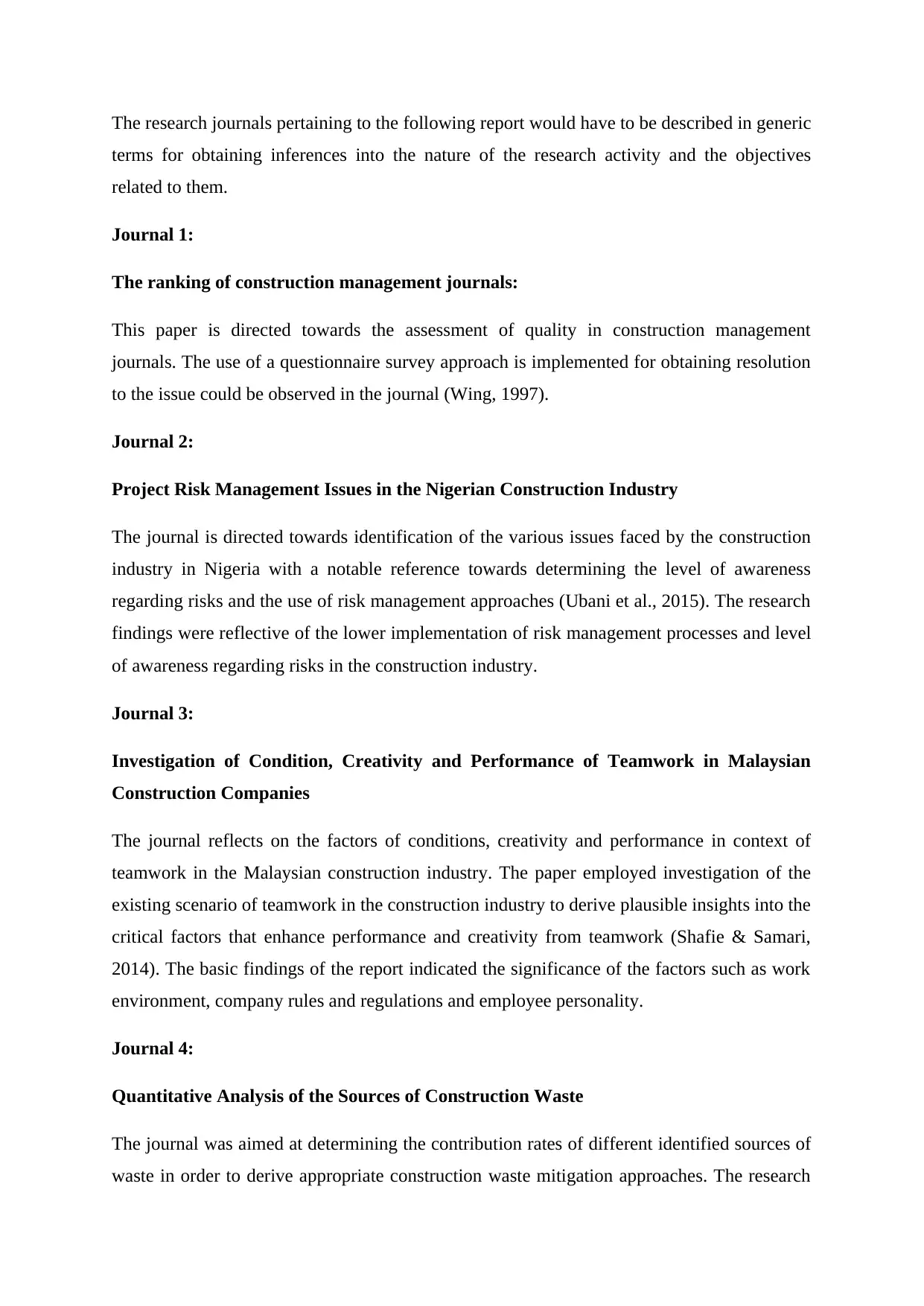
The research journals pertaining to the following report would have to be described in generic
terms for obtaining inferences into the nature of the research activity and the objectives
related to them.
Journal 1:
The ranking of construction management journals:
This paper is directed towards the assessment of quality in construction management
journals. The use of a questionnaire survey approach is implemented for obtaining resolution
to the issue could be observed in the journal (Wing, 1997).
Journal 2:
Project Risk Management Issues in the Nigerian Construction Industry
The journal is directed towards identification of the various issues faced by the construction
industry in Nigeria with a notable reference towards determining the level of awareness
regarding risks and the use of risk management approaches (Ubani et al., 2015). The research
findings were reflective of the lower implementation of risk management processes and level
of awareness regarding risks in the construction industry.
Journal 3:
Investigation of Condition, Creativity and Performance of Teamwork in Malaysian
Construction Companies
The journal reflects on the factors of conditions, creativity and performance in context of
teamwork in the Malaysian construction industry. The paper employed investigation of the
existing scenario of teamwork in the construction industry to derive plausible insights into the
critical factors that enhance performance and creativity from teamwork (Shafie & Samari,
2014). The basic findings of the report indicated the significance of the factors such as work
environment, company rules and regulations and employee personality.
Journal 4:
Quantitative Analysis of the Sources of Construction Waste
The journal was aimed at determining the contribution rates of different identified sources of
waste in order to derive appropriate construction waste mitigation approaches. The research
terms for obtaining inferences into the nature of the research activity and the objectives
related to them.
Journal 1:
The ranking of construction management journals:
This paper is directed towards the assessment of quality in construction management
journals. The use of a questionnaire survey approach is implemented for obtaining resolution
to the issue could be observed in the journal (Wing, 1997).
Journal 2:
Project Risk Management Issues in the Nigerian Construction Industry
The journal is directed towards identification of the various issues faced by the construction
industry in Nigeria with a notable reference towards determining the level of awareness
regarding risks and the use of risk management approaches (Ubani et al., 2015). The research
findings were reflective of the lower implementation of risk management processes and level
of awareness regarding risks in the construction industry.
Journal 3:
Investigation of Condition, Creativity and Performance of Teamwork in Malaysian
Construction Companies
The journal reflects on the factors of conditions, creativity and performance in context of
teamwork in the Malaysian construction industry. The paper employed investigation of the
existing scenario of teamwork in the construction industry to derive plausible insights into the
critical factors that enhance performance and creativity from teamwork (Shafie & Samari,
2014). The basic findings of the report indicated the significance of the factors such as work
environment, company rules and regulations and employee personality.
Journal 4:
Quantitative Analysis of the Sources of Construction Waste
The journal was aimed at determining the contribution rates of different identified sources of
waste in order to derive appropriate construction waste mitigation approaches. The research
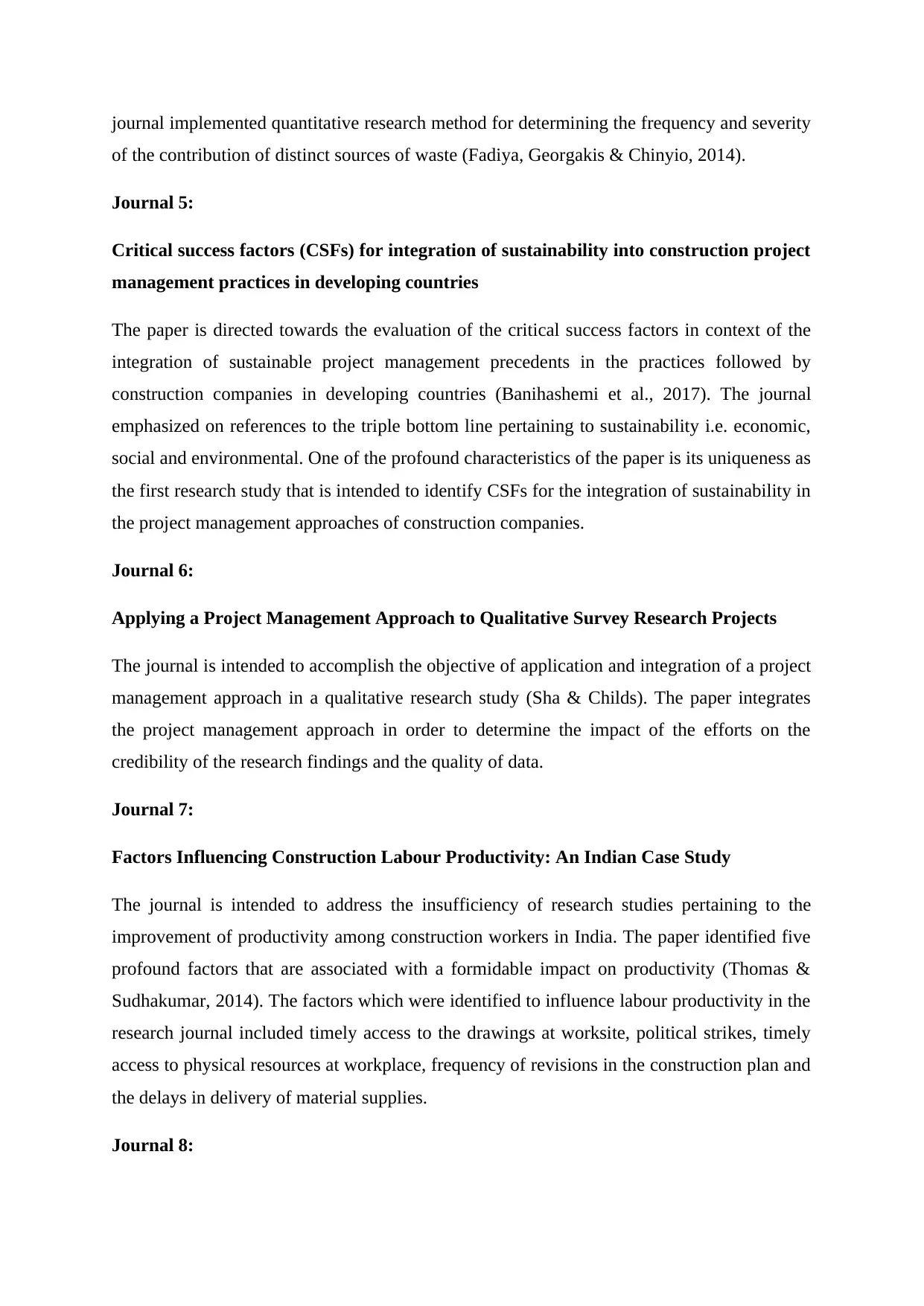
journal implemented quantitative research method for determining the frequency and severity
of the contribution of distinct sources of waste (Fadiya, Georgakis & Chinyio, 2014).
Journal 5:
Critical success factors (CSFs) for integration of sustainability into construction project
management practices in developing countries
The paper is directed towards the evaluation of the critical success factors in context of the
integration of sustainable project management precedents in the practices followed by
construction companies in developing countries (Banihashemi et al., 2017). The journal
emphasized on references to the triple bottom line pertaining to sustainability i.e. economic,
social and environmental. One of the profound characteristics of the paper is its uniqueness as
the first research study that is intended to identify CSFs for the integration of sustainability in
the project management approaches of construction companies.
Journal 6:
Applying a Project Management Approach to Qualitative Survey Research Projects
The journal is intended to accomplish the objective of application and integration of a project
management approach in a qualitative research study (Sha & Childs). The paper integrates
the project management approach in order to determine the impact of the efforts on the
credibility of the research findings and the quality of data.
Journal 7:
Factors Influencing Construction Labour Productivity: An Indian Case Study
The journal is intended to address the insufficiency of research studies pertaining to the
improvement of productivity among construction workers in India. The paper identified five
profound factors that are associated with a formidable impact on productivity (Thomas &
Sudhakumar, 2014). The factors which were identified to influence labour productivity in the
research journal included timely access to the drawings at worksite, political strikes, timely
access to physical resources at workplace, frequency of revisions in the construction plan and
the delays in delivery of material supplies.
Journal 8:
of the contribution of distinct sources of waste (Fadiya, Georgakis & Chinyio, 2014).
Journal 5:
Critical success factors (CSFs) for integration of sustainability into construction project
management practices in developing countries
The paper is directed towards the evaluation of the critical success factors in context of the
integration of sustainable project management precedents in the practices followed by
construction companies in developing countries (Banihashemi et al., 2017). The journal
emphasized on references to the triple bottom line pertaining to sustainability i.e. economic,
social and environmental. One of the profound characteristics of the paper is its uniqueness as
the first research study that is intended to identify CSFs for the integration of sustainability in
the project management approaches of construction companies.
Journal 6:
Applying a Project Management Approach to Qualitative Survey Research Projects
The journal is intended to accomplish the objective of application and integration of a project
management approach in a qualitative research study (Sha & Childs). The paper integrates
the project management approach in order to determine the impact of the efforts on the
credibility of the research findings and the quality of data.
Journal 7:
Factors Influencing Construction Labour Productivity: An Indian Case Study
The journal is intended to address the insufficiency of research studies pertaining to the
improvement of productivity among construction workers in India. The paper identified five
profound factors that are associated with a formidable impact on productivity (Thomas &
Sudhakumar, 2014). The factors which were identified to influence labour productivity in the
research journal included timely access to the drawings at worksite, political strikes, timely
access to physical resources at workplace, frequency of revisions in the construction plan and
the delays in delivery of material supplies.
Journal 8:
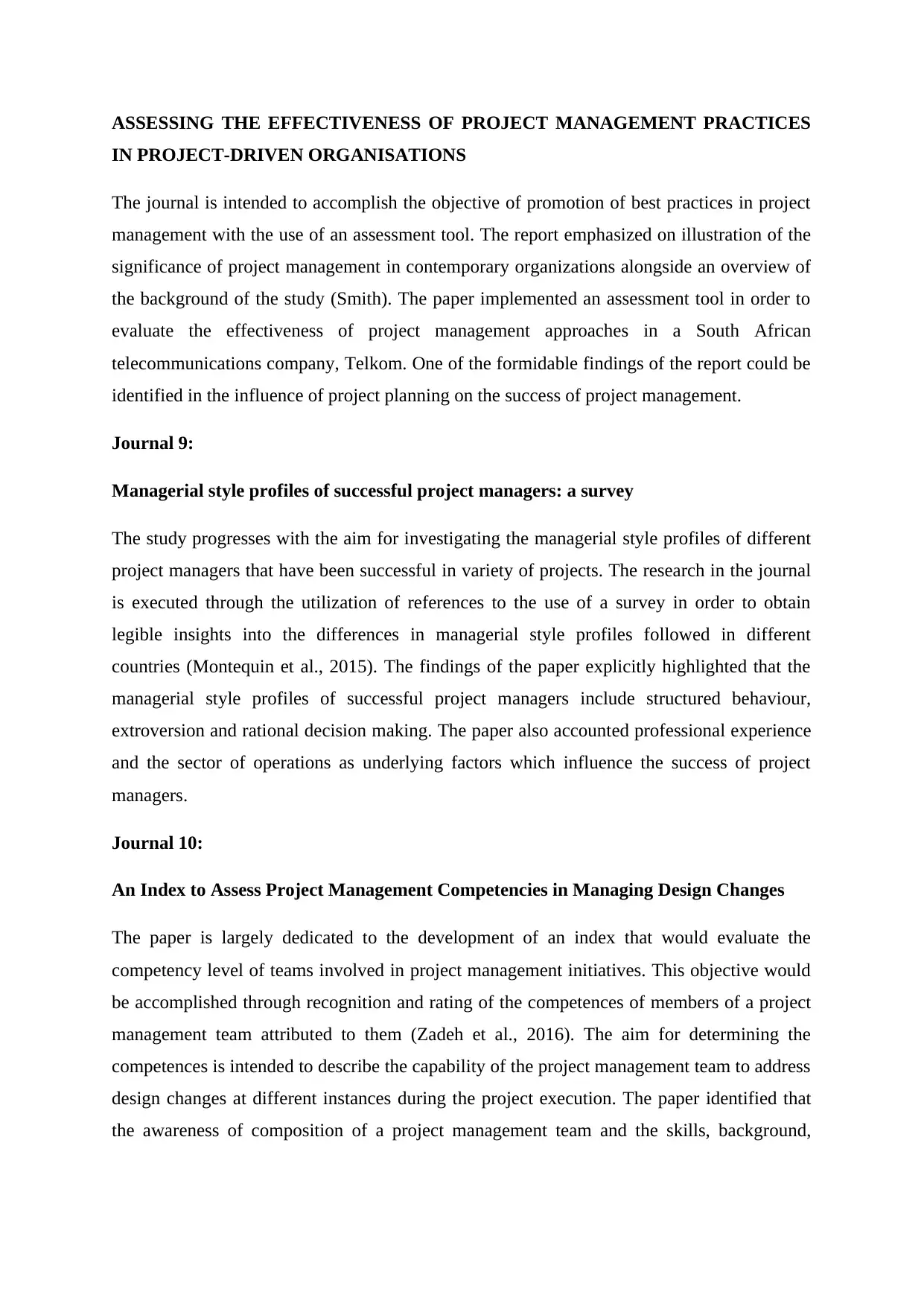
ASSESSING THE EFFECTIVENESS OF PROJECT MANAGEMENT PRACTICES
IN PROJECT-DRIVEN ORGANISATIONS
The journal is intended to accomplish the objective of promotion of best practices in project
management with the use of an assessment tool. The report emphasized on illustration of the
significance of project management in contemporary organizations alongside an overview of
the background of the study (Smith). The paper implemented an assessment tool in order to
evaluate the effectiveness of project management approaches in a South African
telecommunications company, Telkom. One of the formidable findings of the report could be
identified in the influence of project planning on the success of project management.
Journal 9:
Managerial style profiles of successful project managers: a survey
The study progresses with the aim for investigating the managerial style profiles of different
project managers that have been successful in variety of projects. The research in the journal
is executed through the utilization of references to the use of a survey in order to obtain
legible insights into the differences in managerial style profiles followed in different
countries (Montequin et al., 2015). The findings of the paper explicitly highlighted that the
managerial style profiles of successful project managers include structured behaviour,
extroversion and rational decision making. The paper also accounted professional experience
and the sector of operations as underlying factors which influence the success of project
managers.
Journal 10:
An Index to Assess Project Management Competencies in Managing Design Changes
The paper is largely dedicated to the development of an index that would evaluate the
competency level of teams involved in project management initiatives. This objective would
be accomplished through recognition and rating of the competences of members of a project
management team attributed to them (Zadeh et al., 2016). The aim for determining the
competences is intended to describe the capability of the project management team to address
design changes at different instances during the project execution. The paper identified that
the awareness of composition of a project management team and the skills, background,
IN PROJECT-DRIVEN ORGANISATIONS
The journal is intended to accomplish the objective of promotion of best practices in project
management with the use of an assessment tool. The report emphasized on illustration of the
significance of project management in contemporary organizations alongside an overview of
the background of the study (Smith). The paper implemented an assessment tool in order to
evaluate the effectiveness of project management approaches in a South African
telecommunications company, Telkom. One of the formidable findings of the report could be
identified in the influence of project planning on the success of project management.
Journal 9:
Managerial style profiles of successful project managers: a survey
The study progresses with the aim for investigating the managerial style profiles of different
project managers that have been successful in variety of projects. The research in the journal
is executed through the utilization of references to the use of a survey in order to obtain
legible insights into the differences in managerial style profiles followed in different
countries (Montequin et al., 2015). The findings of the paper explicitly highlighted that the
managerial style profiles of successful project managers include structured behaviour,
extroversion and rational decision making. The paper also accounted professional experience
and the sector of operations as underlying factors which influence the success of project
managers.
Journal 10:
An Index to Assess Project Management Competencies in Managing Design Changes
The paper is largely dedicated to the development of an index that would evaluate the
competency level of teams involved in project management initiatives. This objective would
be accomplished through recognition and rating of the competences of members of a project
management team attributed to them (Zadeh et al., 2016). The aim for determining the
competences is intended to describe the capability of the project management team to address
design changes at different instances during the project execution. The paper identified that
the awareness of composition of a project management team and the skills, background,
Secure Best Marks with AI Grader
Need help grading? Try our AI Grader for instant feedback on your assignments.
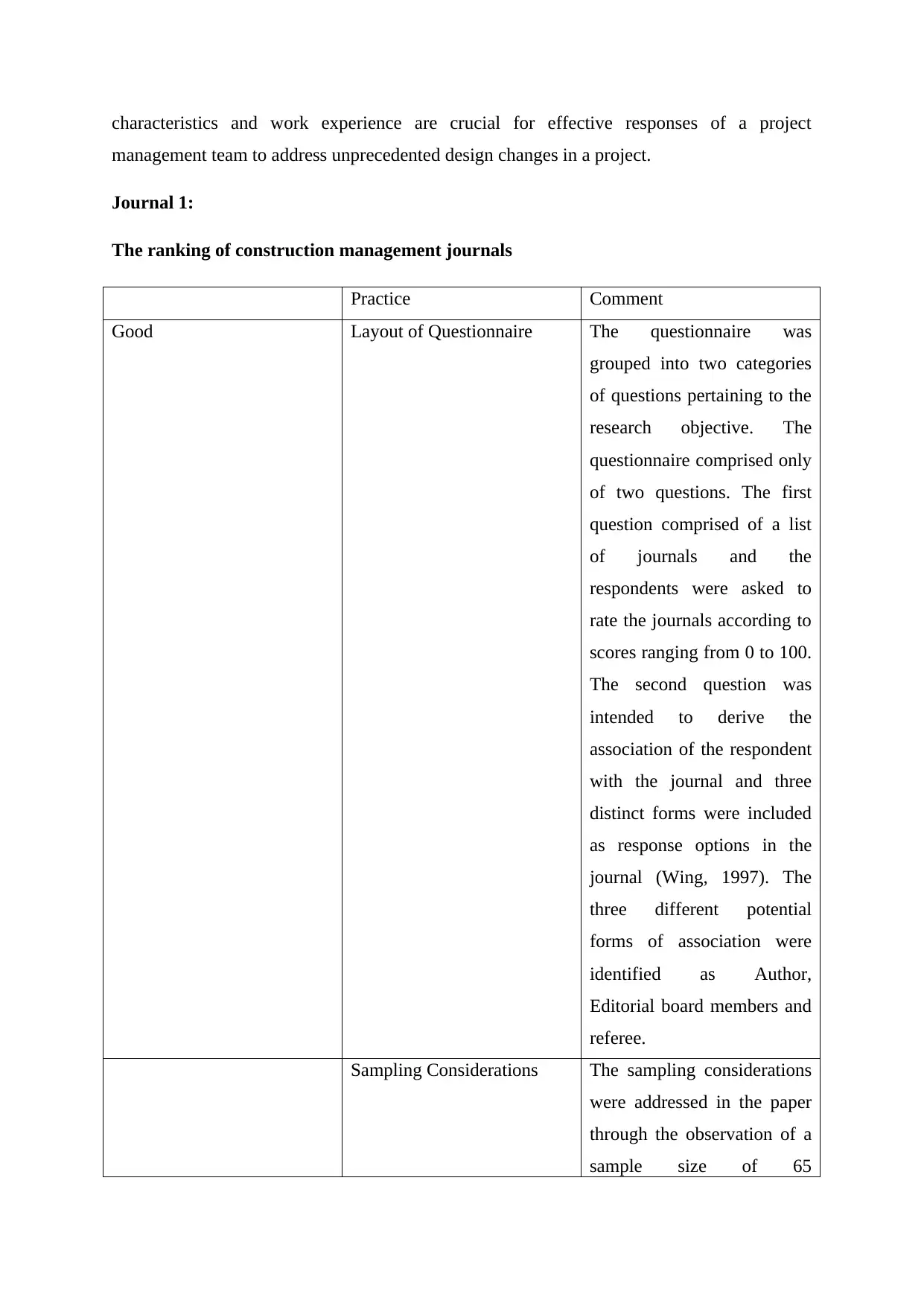
characteristics and work experience are crucial for effective responses of a project
management team to address unprecedented design changes in a project.
Journal 1:
The ranking of construction management journals
Practice Comment
Good Layout of Questionnaire The questionnaire was
grouped into two categories
of questions pertaining to the
research objective. The
questionnaire comprised only
of two questions. The first
question comprised of a list
of journals and the
respondents were asked to
rate the journals according to
scores ranging from 0 to 100.
The second question was
intended to derive the
association of the respondent
with the journal and three
distinct forms were included
as response options in the
journal (Wing, 1997). The
three different potential
forms of association were
identified as Author,
Editorial board members and
referee.
Sampling Considerations The sampling considerations
were addressed in the paper
through the observation of a
sample size of 65
management team to address unprecedented design changes in a project.
Journal 1:
The ranking of construction management journals
Practice Comment
Good Layout of Questionnaire The questionnaire was
grouped into two categories
of questions pertaining to the
research objective. The
questionnaire comprised only
of two questions. The first
question comprised of a list
of journals and the
respondents were asked to
rate the journals according to
scores ranging from 0 to 100.
The second question was
intended to derive the
association of the respondent
with the journal and three
distinct forms were included
as response options in the
journal (Wing, 1997). The
three different potential
forms of association were
identified as Author,
Editorial board members and
referee.
Sampling Considerations The sampling considerations
were addressed in the paper
through the observation of a
sample size of 65
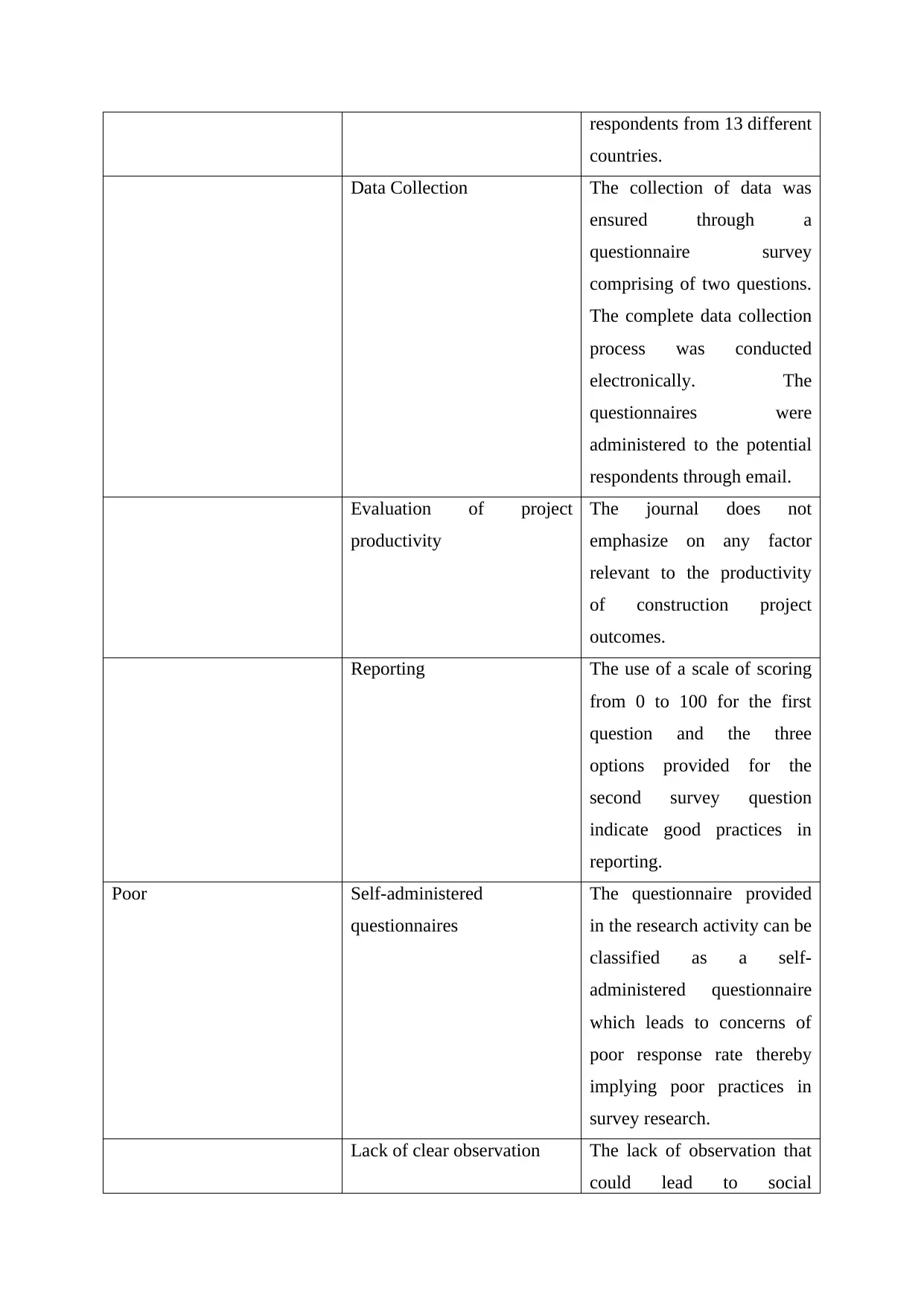
respondents from 13 different
countries.
Data Collection The collection of data was
ensured through a
questionnaire survey
comprising of two questions.
The complete data collection
process was conducted
electronically. The
questionnaires were
administered to the potential
respondents through email.
Evaluation of project
productivity
The journal does not
emphasize on any factor
relevant to the productivity
of construction project
outcomes.
Reporting The use of a scale of scoring
from 0 to 100 for the first
question and the three
options provided for the
second survey question
indicate good practices in
reporting.
Poor Self-administered
questionnaires
The questionnaire provided
in the research activity can be
classified as a self-
administered questionnaire
which leads to concerns of
poor response rate thereby
implying poor practices in
survey research.
Lack of clear observation The lack of observation that
could lead to social
countries.
Data Collection The collection of data was
ensured through a
questionnaire survey
comprising of two questions.
The complete data collection
process was conducted
electronically. The
questionnaires were
administered to the potential
respondents through email.
Evaluation of project
productivity
The journal does not
emphasize on any factor
relevant to the productivity
of construction project
outcomes.
Reporting The use of a scale of scoring
from 0 to 100 for the first
question and the three
options provided for the
second survey question
indicate good practices in
reporting.
Poor Self-administered
questionnaires
The questionnaire provided
in the research activity can be
classified as a self-
administered questionnaire
which leads to concerns of
poor response rate thereby
implying poor practices in
survey research.
Lack of clear observation The lack of observation that
could lead to social
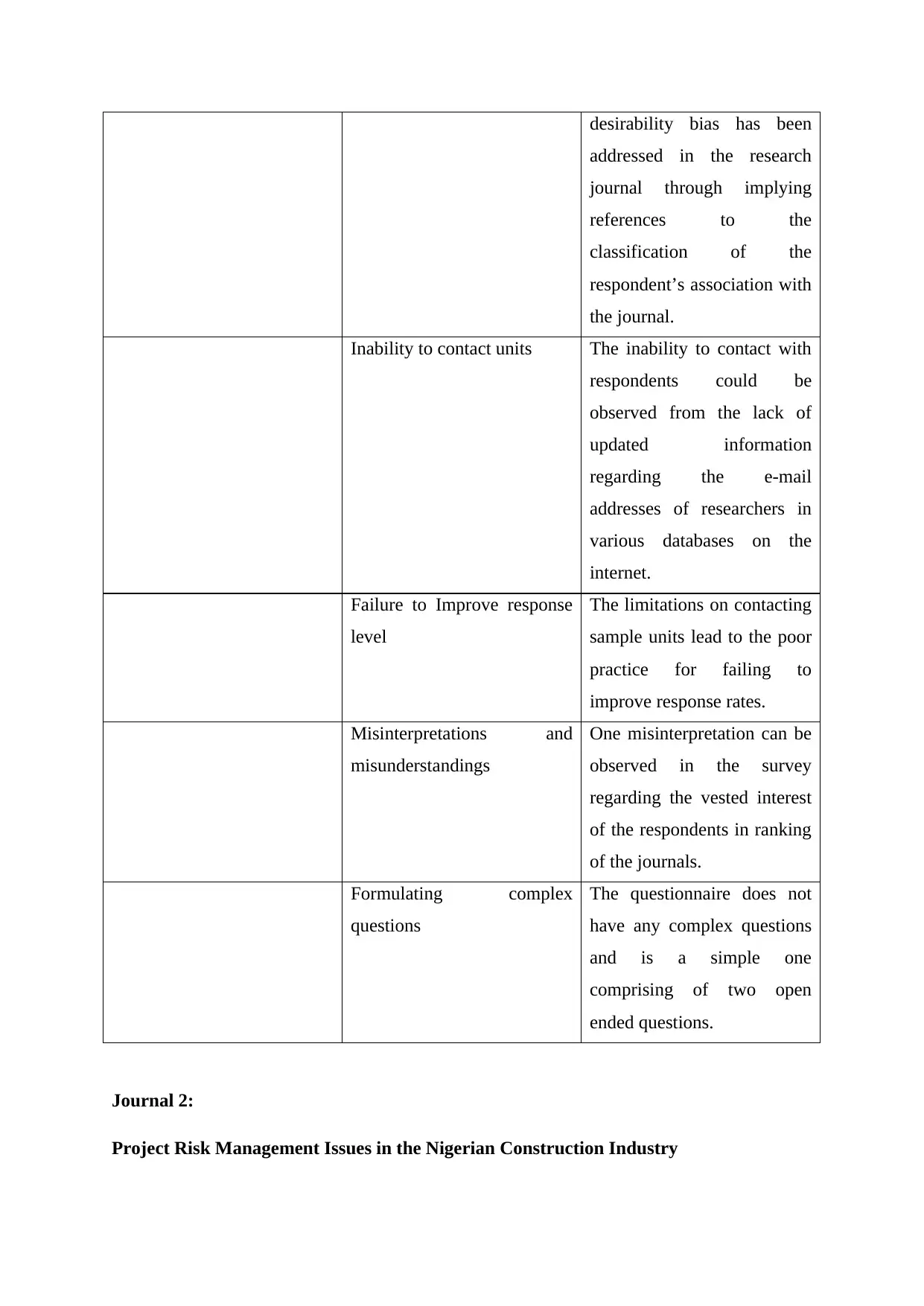
desirability bias has been
addressed in the research
journal through implying
references to the
classification of the
respondent’s association with
the journal.
Inability to contact units The inability to contact with
respondents could be
observed from the lack of
updated information
regarding the e-mail
addresses of researchers in
various databases on the
internet.
Failure to Improve response
level
The limitations on contacting
sample units lead to the poor
practice for failing to
improve response rates.
Misinterpretations and
misunderstandings
One misinterpretation can be
observed in the survey
regarding the vested interest
of the respondents in ranking
of the journals.
Formulating complex
questions
The questionnaire does not
have any complex questions
and is a simple one
comprising of two open
ended questions.
Journal 2:
Project Risk Management Issues in the Nigerian Construction Industry
addressed in the research
journal through implying
references to the
classification of the
respondent’s association with
the journal.
Inability to contact units The inability to contact with
respondents could be
observed from the lack of
updated information
regarding the e-mail
addresses of researchers in
various databases on the
internet.
Failure to Improve response
level
The limitations on contacting
sample units lead to the poor
practice for failing to
improve response rates.
Misinterpretations and
misunderstandings
One misinterpretation can be
observed in the survey
regarding the vested interest
of the respondents in ranking
of the journals.
Formulating complex
questions
The questionnaire does not
have any complex questions
and is a simple one
comprising of two open
ended questions.
Journal 2:
Project Risk Management Issues in the Nigerian Construction Industry
Paraphrase This Document
Need a fresh take? Get an instant paraphrase of this document with our AI Paraphraser
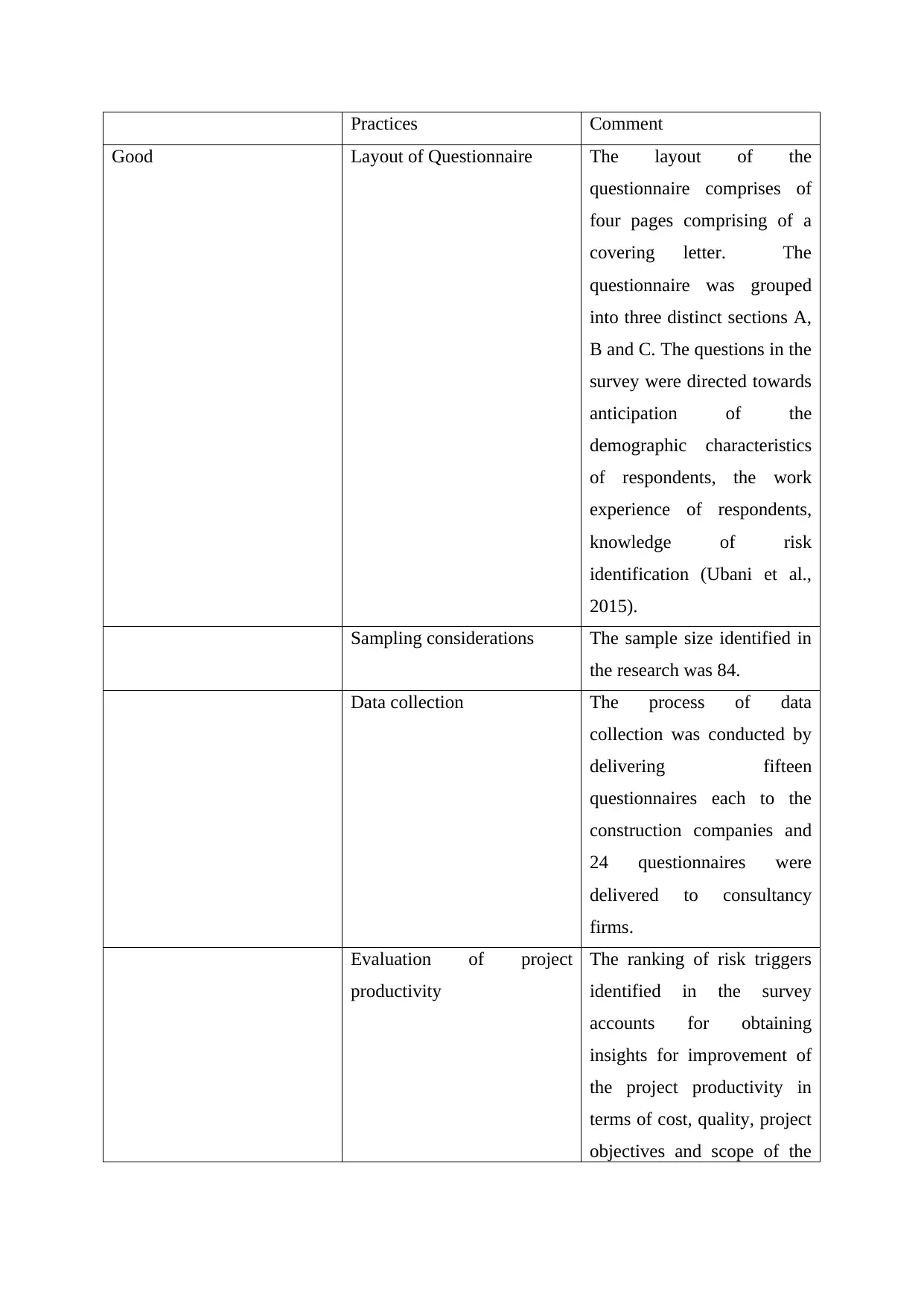
Practices Comment
Good Layout of Questionnaire The layout of the
questionnaire comprises of
four pages comprising of a
covering letter. The
questionnaire was grouped
into three distinct sections A,
B and C. The questions in the
survey were directed towards
anticipation of the
demographic characteristics
of respondents, the work
experience of respondents,
knowledge of risk
identification (Ubani et al.,
2015).
Sampling considerations The sample size identified in
the research was 84.
Data collection The process of data
collection was conducted by
delivering fifteen
questionnaires each to the
construction companies and
24 questionnaires were
delivered to consultancy
firms.
Evaluation of project
productivity
The ranking of risk triggers
identified in the survey
accounts for obtaining
insights for improvement of
the project productivity in
terms of cost, quality, project
objectives and scope of the
Good Layout of Questionnaire The layout of the
questionnaire comprises of
four pages comprising of a
covering letter. The
questionnaire was grouped
into three distinct sections A,
B and C. The questions in the
survey were directed towards
anticipation of the
demographic characteristics
of respondents, the work
experience of respondents,
knowledge of risk
identification (Ubani et al.,
2015).
Sampling considerations The sample size identified in
the research was 84.
Data collection The process of data
collection was conducted by
delivering fifteen
questionnaires each to the
construction companies and
24 questionnaires were
delivered to consultancy
firms.
Evaluation of project
productivity
The ranking of risk triggers
identified in the survey
accounts for obtaining
insights for improvement of
the project productivity in
terms of cost, quality, project
objectives and scope of the
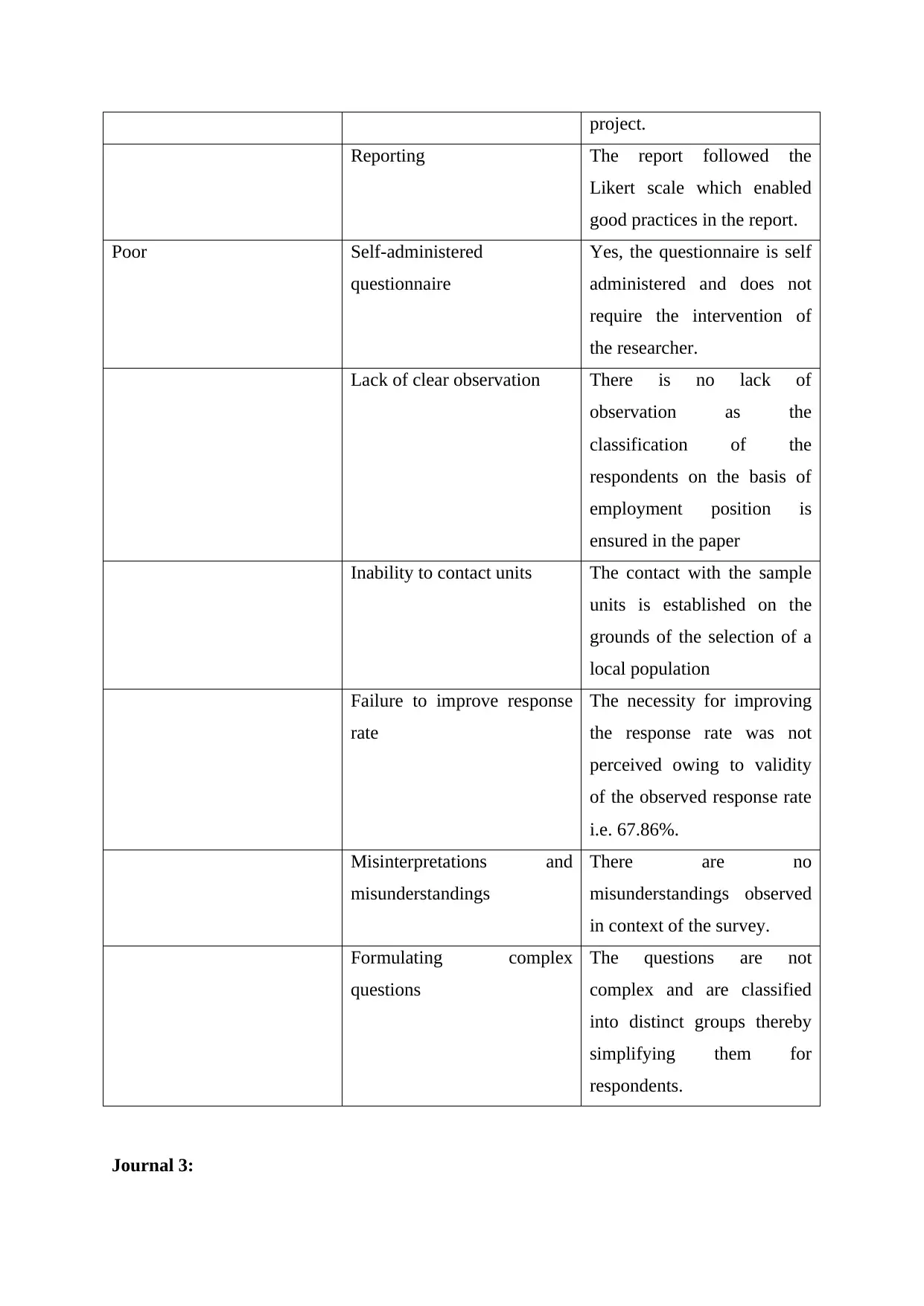
project.
Reporting The report followed the
Likert scale which enabled
good practices in the report.
Poor Self-administered
questionnaire
Yes, the questionnaire is self
administered and does not
require the intervention of
the researcher.
Lack of clear observation There is no lack of
observation as the
classification of the
respondents on the basis of
employment position is
ensured in the paper
Inability to contact units The contact with the sample
units is established on the
grounds of the selection of a
local population
Failure to improve response
rate
The necessity for improving
the response rate was not
perceived owing to validity
of the observed response rate
i.e. 67.86%.
Misinterpretations and
misunderstandings
There are no
misunderstandings observed
in context of the survey.
Formulating complex
questions
The questions are not
complex and are classified
into distinct groups thereby
simplifying them for
respondents.
Journal 3:
Reporting The report followed the
Likert scale which enabled
good practices in the report.
Poor Self-administered
questionnaire
Yes, the questionnaire is self
administered and does not
require the intervention of
the researcher.
Lack of clear observation There is no lack of
observation as the
classification of the
respondents on the basis of
employment position is
ensured in the paper
Inability to contact units The contact with the sample
units is established on the
grounds of the selection of a
local population
Failure to improve response
rate
The necessity for improving
the response rate was not
perceived owing to validity
of the observed response rate
i.e. 67.86%.
Misinterpretations and
misunderstandings
There are no
misunderstandings observed
in context of the survey.
Formulating complex
questions
The questions are not
complex and are classified
into distinct groups thereby
simplifying them for
respondents.
Journal 3:
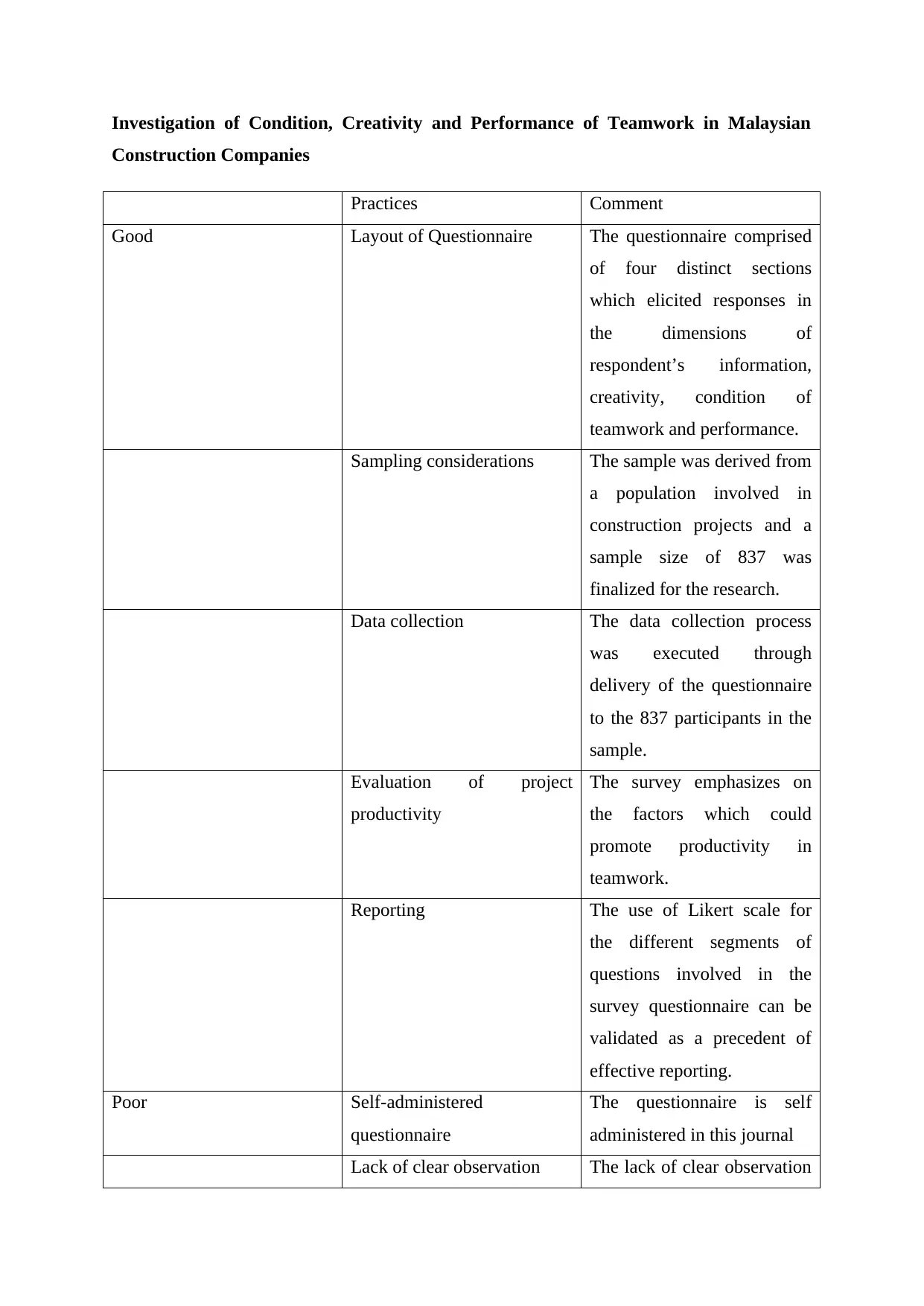
Investigation of Condition, Creativity and Performance of Teamwork in Malaysian
Construction Companies
Practices Comment
Good Layout of Questionnaire The questionnaire comprised
of four distinct sections
which elicited responses in
the dimensions of
respondent’s information,
creativity, condition of
teamwork and performance.
Sampling considerations The sample was derived from
a population involved in
construction projects and a
sample size of 837 was
finalized for the research.
Data collection The data collection process
was executed through
delivery of the questionnaire
to the 837 participants in the
sample.
Evaluation of project
productivity
The survey emphasizes on
the factors which could
promote productivity in
teamwork.
Reporting The use of Likert scale for
the different segments of
questions involved in the
survey questionnaire can be
validated as a precedent of
effective reporting.
Poor Self-administered
questionnaire
The questionnaire is self
administered in this journal
Lack of clear observation The lack of clear observation
Construction Companies
Practices Comment
Good Layout of Questionnaire The questionnaire comprised
of four distinct sections
which elicited responses in
the dimensions of
respondent’s information,
creativity, condition of
teamwork and performance.
Sampling considerations The sample was derived from
a population involved in
construction projects and a
sample size of 837 was
finalized for the research.
Data collection The data collection process
was executed through
delivery of the questionnaire
to the 837 participants in the
sample.
Evaluation of project
productivity
The survey emphasizes on
the factors which could
promote productivity in
teamwork.
Reporting The use of Likert scale for
the different segments of
questions involved in the
survey questionnaire can be
validated as a precedent of
effective reporting.
Poor Self-administered
questionnaire
The questionnaire is self
administered in this journal
Lack of clear observation The lack of clear observation
Secure Best Marks with AI Grader
Need help grading? Try our AI Grader for instant feedback on your assignments.
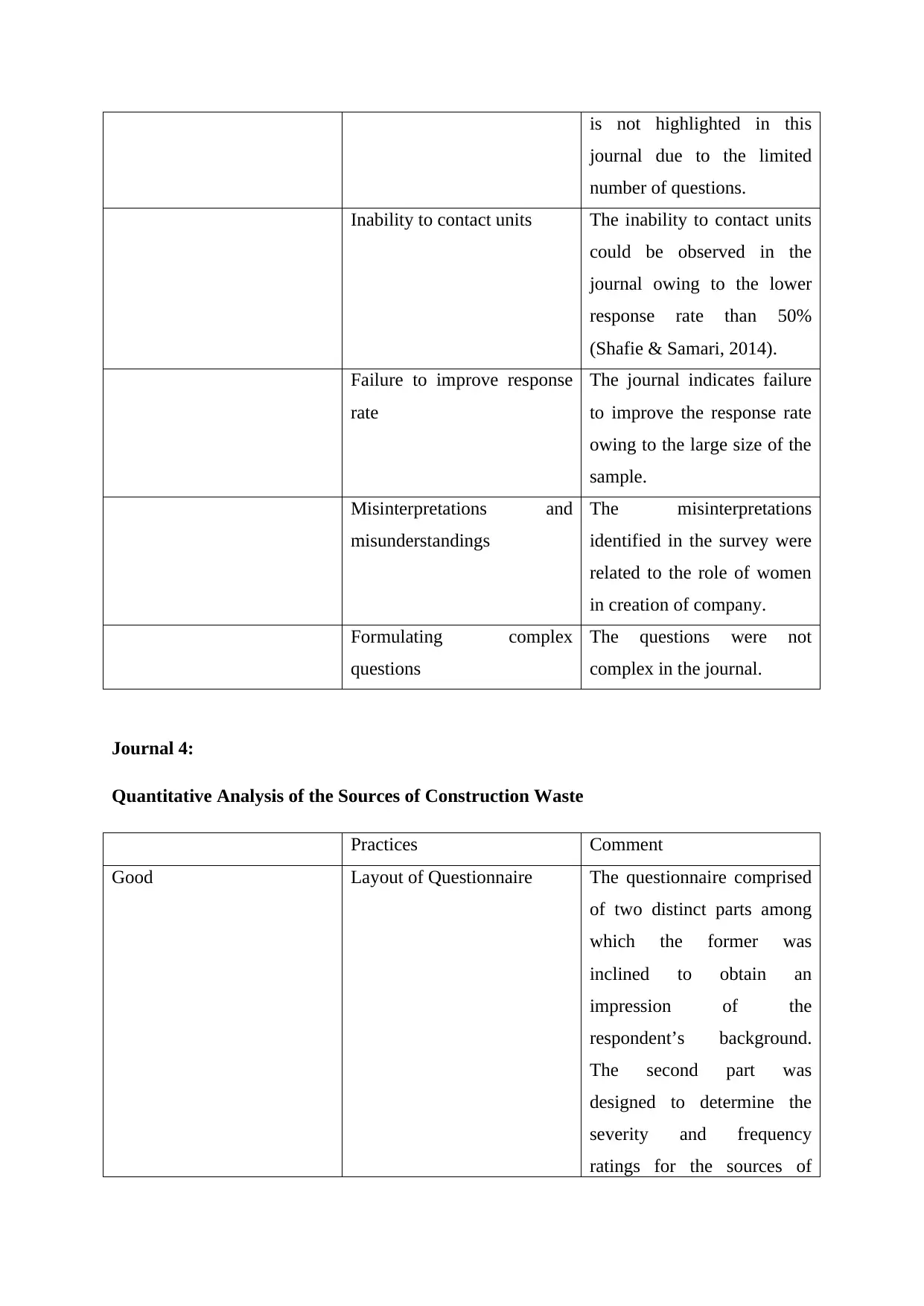
is not highlighted in this
journal due to the limited
number of questions.
Inability to contact units The inability to contact units
could be observed in the
journal owing to the lower
response rate than 50%
(Shafie & Samari, 2014).
Failure to improve response
rate
The journal indicates failure
to improve the response rate
owing to the large size of the
sample.
Misinterpretations and
misunderstandings
The misinterpretations
identified in the survey were
related to the role of women
in creation of company.
Formulating complex
questions
The questions were not
complex in the journal.
Journal 4:
Quantitative Analysis of the Sources of Construction Waste
Practices Comment
Good Layout of Questionnaire The questionnaire comprised
of two distinct parts among
which the former was
inclined to obtain an
impression of the
respondent’s background.
The second part was
designed to determine the
severity and frequency
ratings for the sources of
journal due to the limited
number of questions.
Inability to contact units The inability to contact units
could be observed in the
journal owing to the lower
response rate than 50%
(Shafie & Samari, 2014).
Failure to improve response
rate
The journal indicates failure
to improve the response rate
owing to the large size of the
sample.
Misinterpretations and
misunderstandings
The misinterpretations
identified in the survey were
related to the role of women
in creation of company.
Formulating complex
questions
The questions were not
complex in the journal.
Journal 4:
Quantitative Analysis of the Sources of Construction Waste
Practices Comment
Good Layout of Questionnaire The questionnaire comprised
of two distinct parts among
which the former was
inclined to obtain an
impression of the
respondent’s background.
The second part was
designed to determine the
severity and frequency
ratings for the sources of
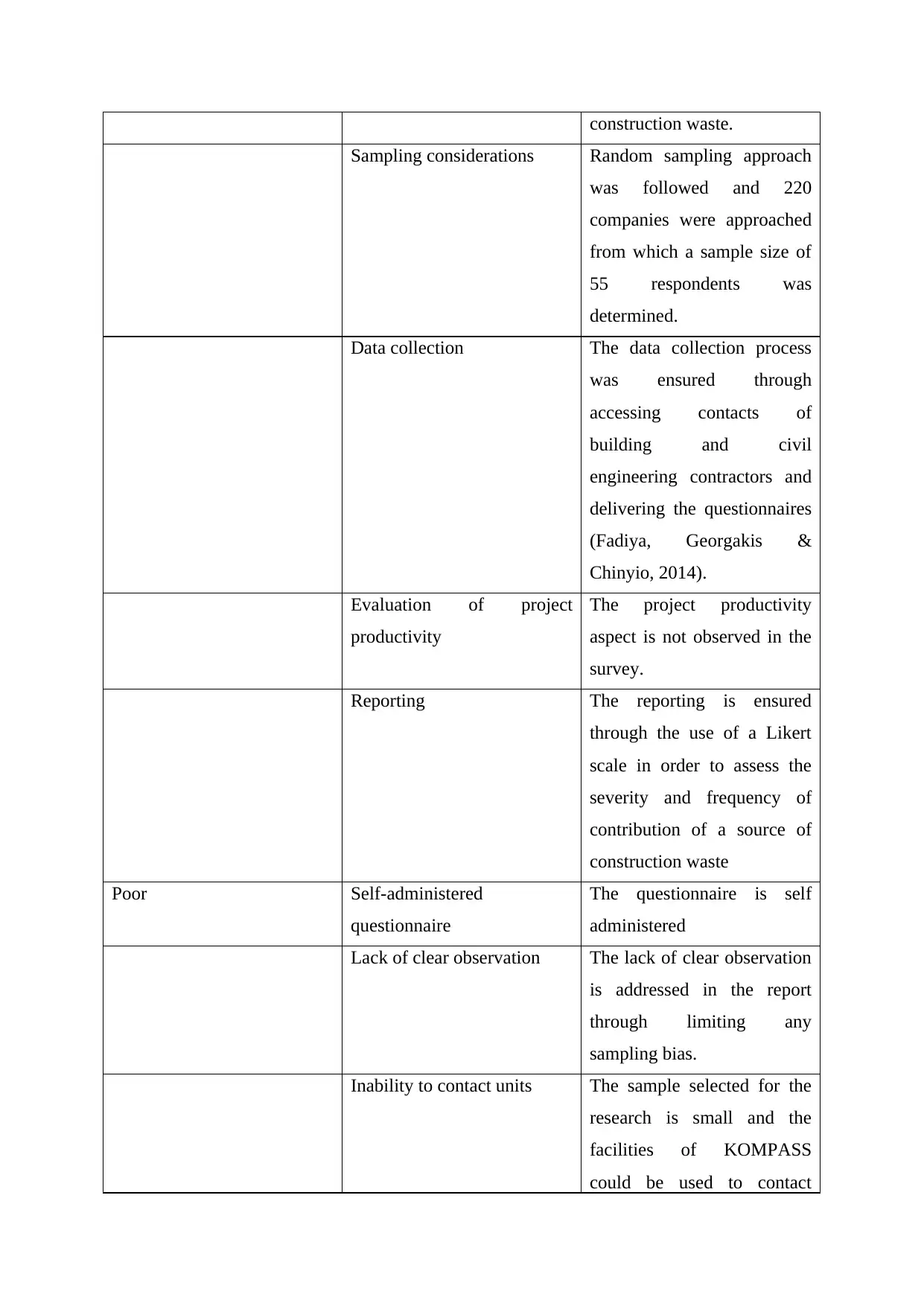
construction waste.
Sampling considerations Random sampling approach
was followed and 220
companies were approached
from which a sample size of
55 respondents was
determined.
Data collection The data collection process
was ensured through
accessing contacts of
building and civil
engineering contractors and
delivering the questionnaires
(Fadiya, Georgakis &
Chinyio, 2014).
Evaluation of project
productivity
The project productivity
aspect is not observed in the
survey.
Reporting The reporting is ensured
through the use of a Likert
scale in order to assess the
severity and frequency of
contribution of a source of
construction waste
Poor Self-administered
questionnaire
The questionnaire is self
administered
Lack of clear observation The lack of clear observation
is addressed in the report
through limiting any
sampling bias.
Inability to contact units The sample selected for the
research is small and the
facilities of KOMPASS
could be used to contact
Sampling considerations Random sampling approach
was followed and 220
companies were approached
from which a sample size of
55 respondents was
determined.
Data collection The data collection process
was ensured through
accessing contacts of
building and civil
engineering contractors and
delivering the questionnaires
(Fadiya, Georgakis &
Chinyio, 2014).
Evaluation of project
productivity
The project productivity
aspect is not observed in the
survey.
Reporting The reporting is ensured
through the use of a Likert
scale in order to assess the
severity and frequency of
contribution of a source of
construction waste
Poor Self-administered
questionnaire
The questionnaire is self
administered
Lack of clear observation The lack of clear observation
is addressed in the report
through limiting any
sampling bias.
Inability to contact units The sample selected for the
research is small and the
facilities of KOMPASS
could be used to contact
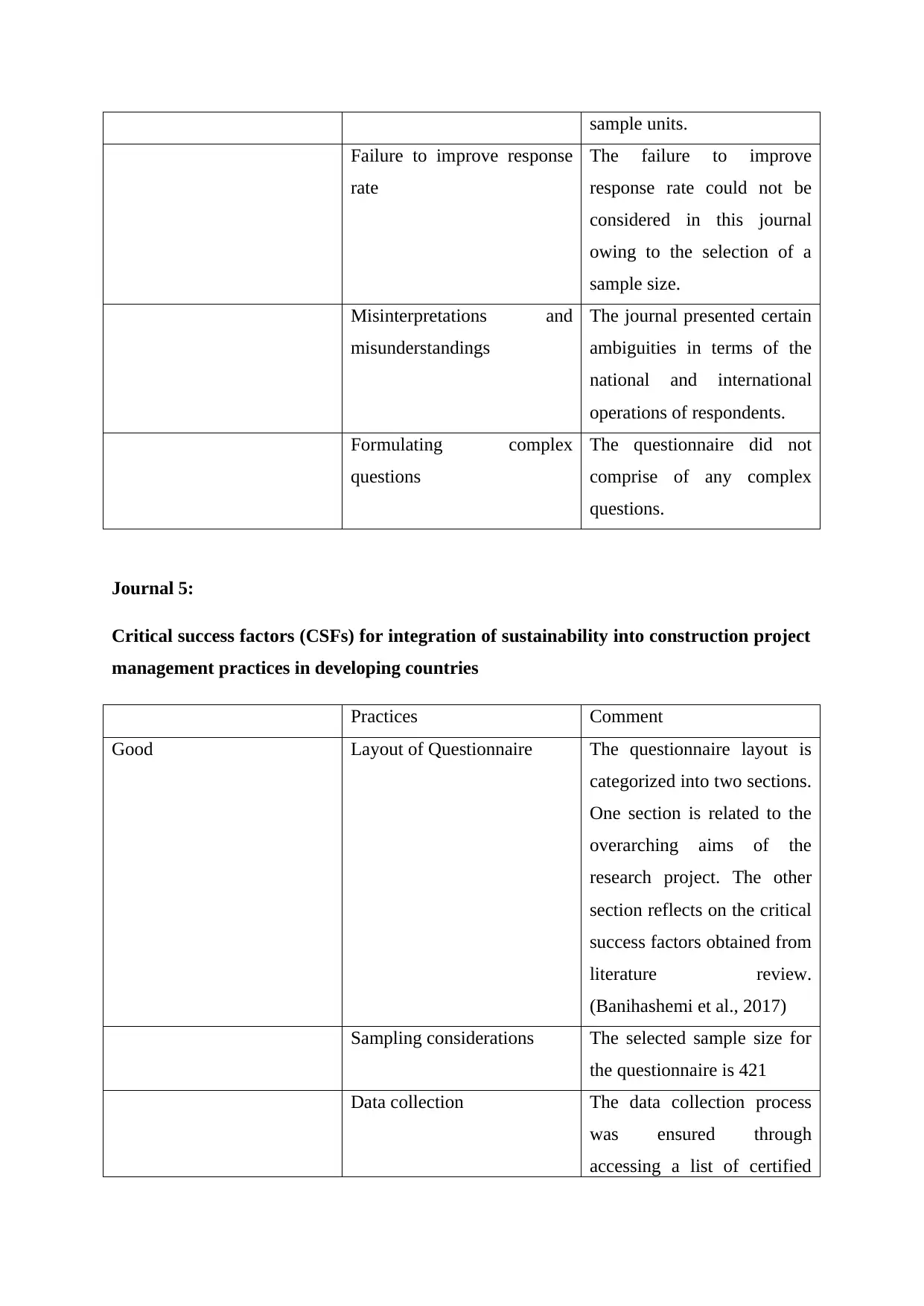
sample units.
Failure to improve response
rate
The failure to improve
response rate could not be
considered in this journal
owing to the selection of a
sample size.
Misinterpretations and
misunderstandings
The journal presented certain
ambiguities in terms of the
national and international
operations of respondents.
Formulating complex
questions
The questionnaire did not
comprise of any complex
questions.
Journal 5:
Critical success factors (CSFs) for integration of sustainability into construction project
management practices in developing countries
Practices Comment
Good Layout of Questionnaire The questionnaire layout is
categorized into two sections.
One section is related to the
overarching aims of the
research project. The other
section reflects on the critical
success factors obtained from
literature review.
(Banihashemi et al., 2017)
Sampling considerations The selected sample size for
the questionnaire is 421
Data collection The data collection process
was ensured through
accessing a list of certified
Failure to improve response
rate
The failure to improve
response rate could not be
considered in this journal
owing to the selection of a
sample size.
Misinterpretations and
misunderstandings
The journal presented certain
ambiguities in terms of the
national and international
operations of respondents.
Formulating complex
questions
The questionnaire did not
comprise of any complex
questions.
Journal 5:
Critical success factors (CSFs) for integration of sustainability into construction project
management practices in developing countries
Practices Comment
Good Layout of Questionnaire The questionnaire layout is
categorized into two sections.
One section is related to the
overarching aims of the
research project. The other
section reflects on the critical
success factors obtained from
literature review.
(Banihashemi et al., 2017)
Sampling considerations The selected sample size for
the questionnaire is 421
Data collection The data collection process
was ensured through
accessing a list of certified
Paraphrase This Document
Need a fresh take? Get an instant paraphrase of this document with our AI Paraphraser
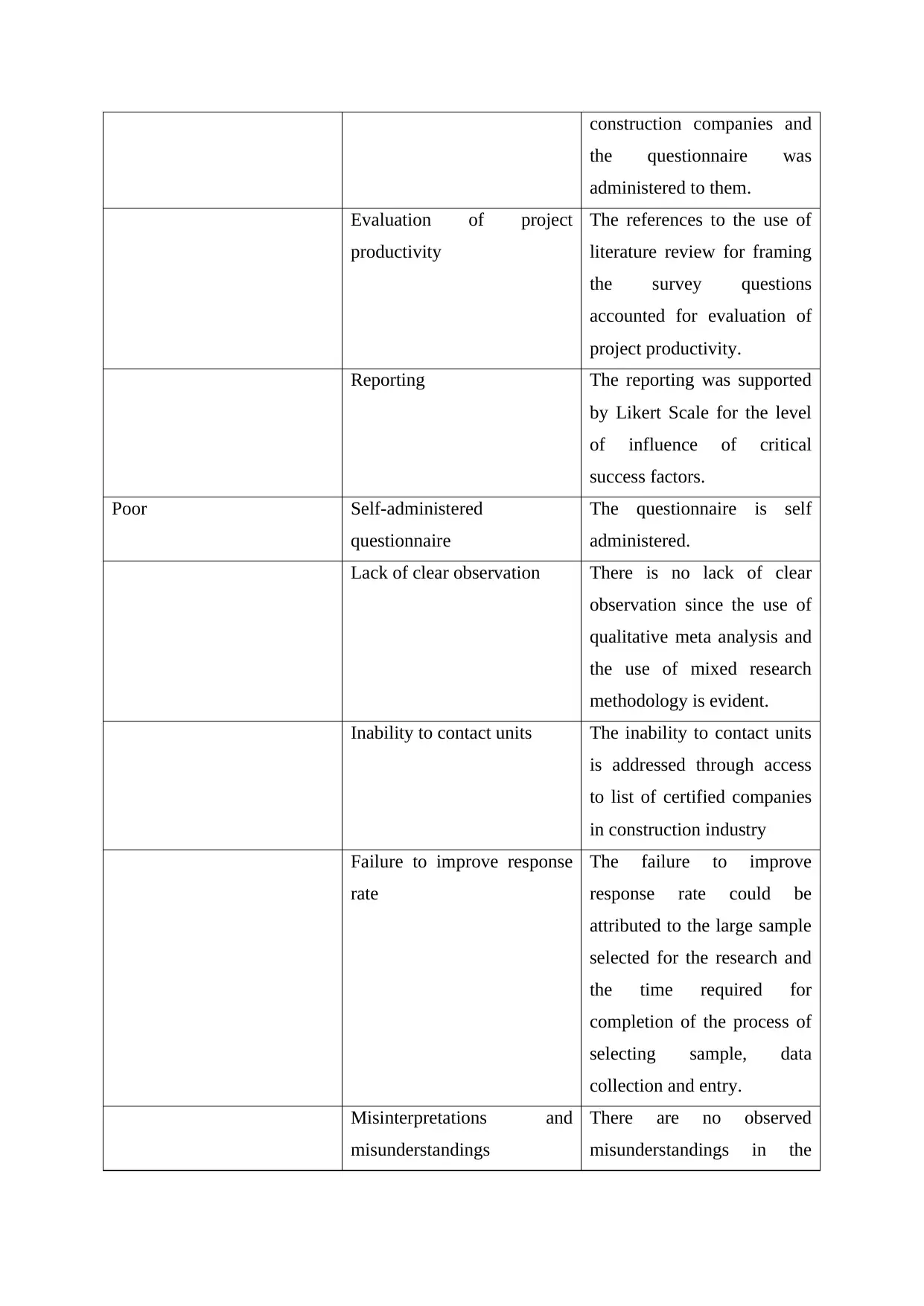
construction companies and
the questionnaire was
administered to them.
Evaluation of project
productivity
The references to the use of
literature review for framing
the survey questions
accounted for evaluation of
project productivity.
Reporting The reporting was supported
by Likert Scale for the level
of influence of critical
success factors.
Poor Self-administered
questionnaire
The questionnaire is self
administered.
Lack of clear observation There is no lack of clear
observation since the use of
qualitative meta analysis and
the use of mixed research
methodology is evident.
Inability to contact units The inability to contact units
is addressed through access
to list of certified companies
in construction industry
Failure to improve response
rate
The failure to improve
response rate could be
attributed to the large sample
selected for the research and
the time required for
completion of the process of
selecting sample, data
collection and entry.
Misinterpretations and
misunderstandings
There are no observed
misunderstandings in the
the questionnaire was
administered to them.
Evaluation of project
productivity
The references to the use of
literature review for framing
the survey questions
accounted for evaluation of
project productivity.
Reporting The reporting was supported
by Likert Scale for the level
of influence of critical
success factors.
Poor Self-administered
questionnaire
The questionnaire is self
administered.
Lack of clear observation There is no lack of clear
observation since the use of
qualitative meta analysis and
the use of mixed research
methodology is evident.
Inability to contact units The inability to contact units
is addressed through access
to list of certified companies
in construction industry
Failure to improve response
rate
The failure to improve
response rate could be
attributed to the large sample
selected for the research and
the time required for
completion of the process of
selecting sample, data
collection and entry.
Misinterpretations and
misunderstandings
There are no observed
misunderstandings in the
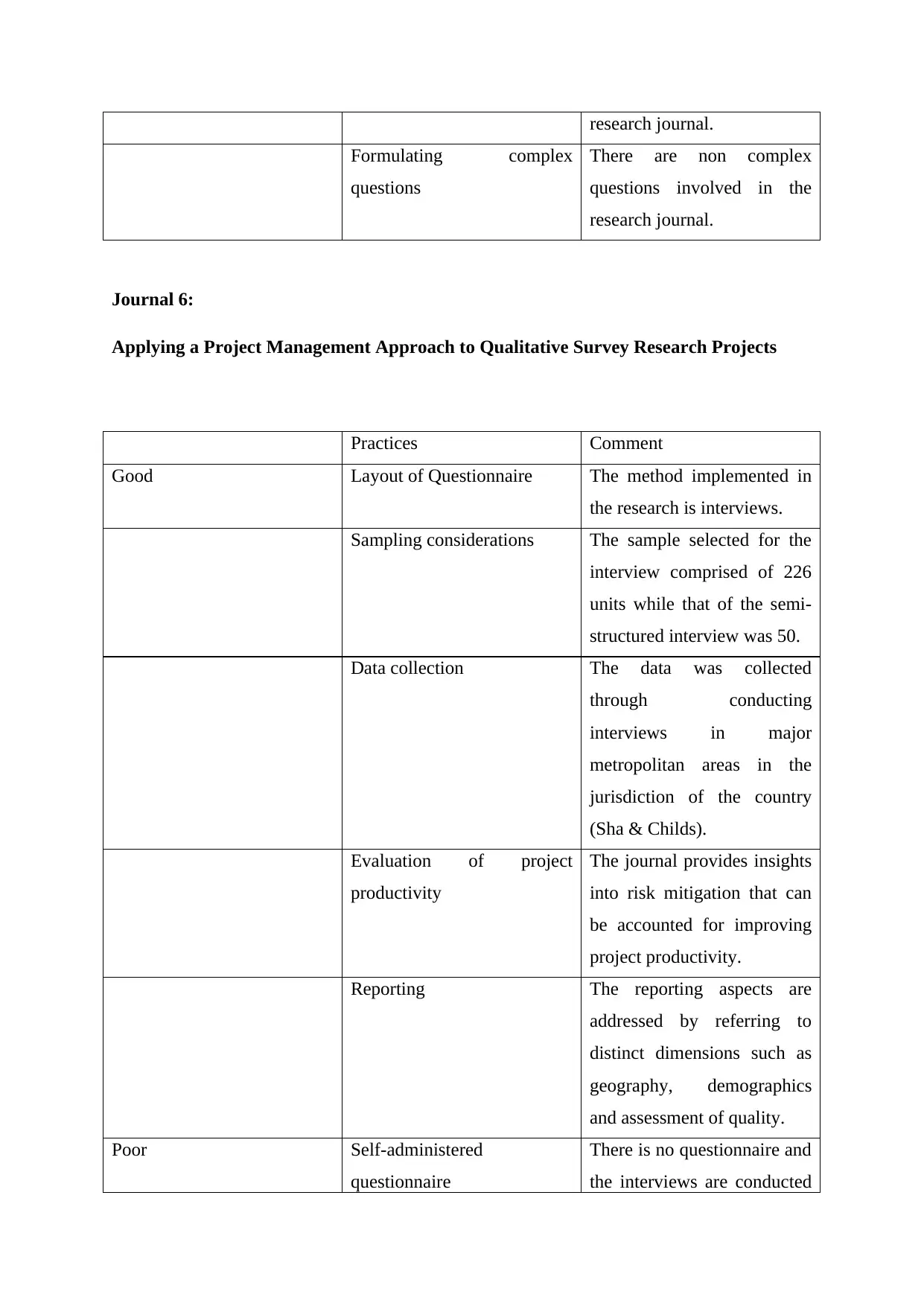
research journal.
Formulating complex
questions
There are non complex
questions involved in the
research journal.
Journal 6:
Applying a Project Management Approach to Qualitative Survey Research Projects
Practices Comment
Good Layout of Questionnaire The method implemented in
the research is interviews.
Sampling considerations The sample selected for the
interview comprised of 226
units while that of the semi-
structured interview was 50.
Data collection The data was collected
through conducting
interviews in major
metropolitan areas in the
jurisdiction of the country
(Sha & Childs).
Evaluation of project
productivity
The journal provides insights
into risk mitigation that can
be accounted for improving
project productivity.
Reporting The reporting aspects are
addressed by referring to
distinct dimensions such as
geography, demographics
and assessment of quality.
Poor Self-administered
questionnaire
There is no questionnaire and
the interviews are conducted
Formulating complex
questions
There are non complex
questions involved in the
research journal.
Journal 6:
Applying a Project Management Approach to Qualitative Survey Research Projects
Practices Comment
Good Layout of Questionnaire The method implemented in
the research is interviews.
Sampling considerations The sample selected for the
interview comprised of 226
units while that of the semi-
structured interview was 50.
Data collection The data was collected
through conducting
interviews in major
metropolitan areas in the
jurisdiction of the country
(Sha & Childs).
Evaluation of project
productivity
The journal provides insights
into risk mitigation that can
be accounted for improving
project productivity.
Reporting The reporting aspects are
addressed by referring to
distinct dimensions such as
geography, demographics
and assessment of quality.
Poor Self-administered
questionnaire
There is no questionnaire and
the interviews are conducted
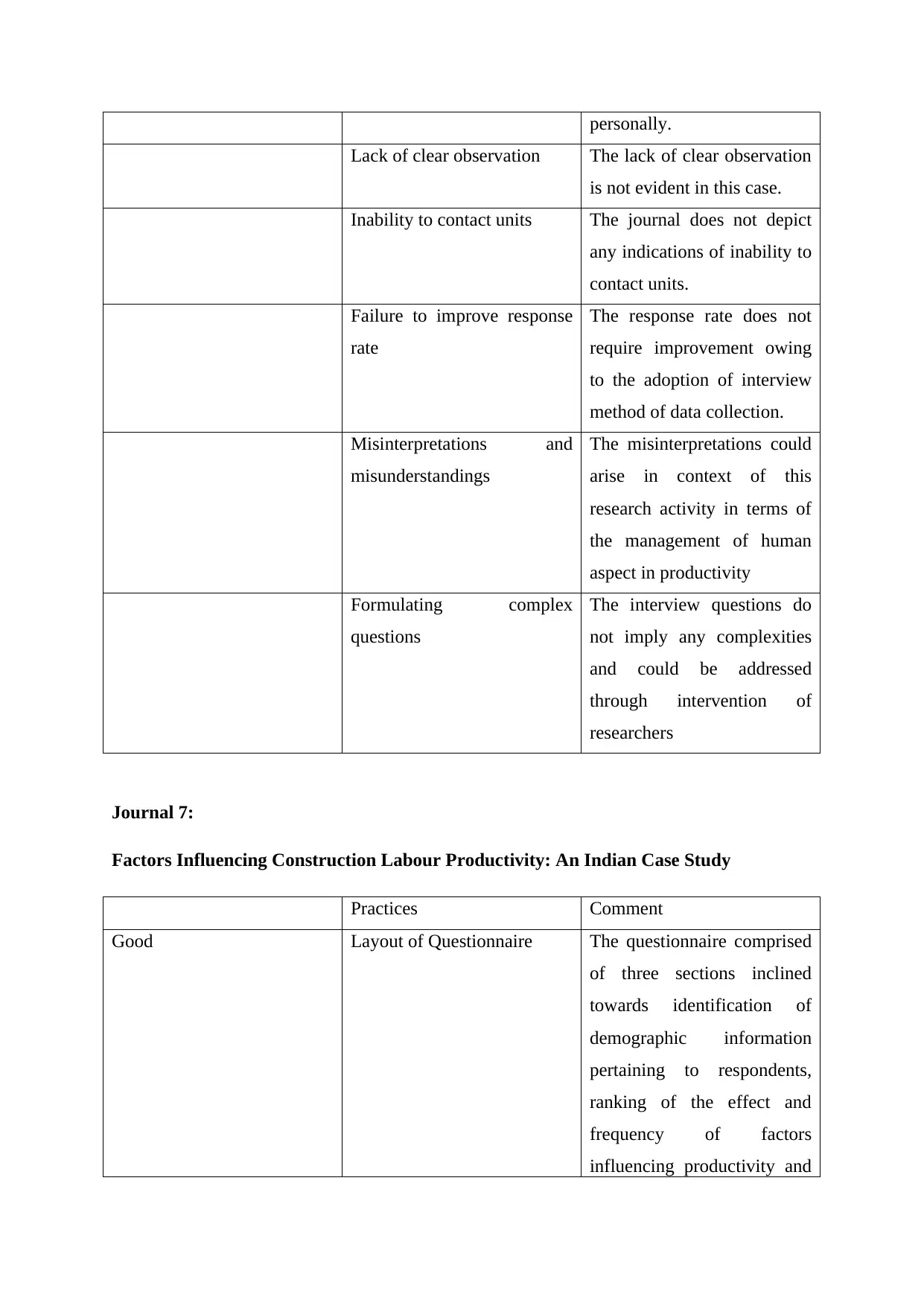
personally.
Lack of clear observation The lack of clear observation
is not evident in this case.
Inability to contact units The journal does not depict
any indications of inability to
contact units.
Failure to improve response
rate
The response rate does not
require improvement owing
to the adoption of interview
method of data collection.
Misinterpretations and
misunderstandings
The misinterpretations could
arise in context of this
research activity in terms of
the management of human
aspect in productivity
Formulating complex
questions
The interview questions do
not imply any complexities
and could be addressed
through intervention of
researchers
Journal 7:
Factors Influencing Construction Labour Productivity: An Indian Case Study
Practices Comment
Good Layout of Questionnaire The questionnaire comprised
of three sections inclined
towards identification of
demographic information
pertaining to respondents,
ranking of the effect and
frequency of factors
influencing productivity and
Lack of clear observation The lack of clear observation
is not evident in this case.
Inability to contact units The journal does not depict
any indications of inability to
contact units.
Failure to improve response
rate
The response rate does not
require improvement owing
to the adoption of interview
method of data collection.
Misinterpretations and
misunderstandings
The misinterpretations could
arise in context of this
research activity in terms of
the management of human
aspect in productivity
Formulating complex
questions
The interview questions do
not imply any complexities
and could be addressed
through intervention of
researchers
Journal 7:
Factors Influencing Construction Labour Productivity: An Indian Case Study
Practices Comment
Good Layout of Questionnaire The questionnaire comprised
of three sections inclined
towards identification of
demographic information
pertaining to respondents,
ranking of the effect and
frequency of factors
influencing productivity and
Secure Best Marks with AI Grader
Need help grading? Try our AI Grader for instant feedback on your assignments.
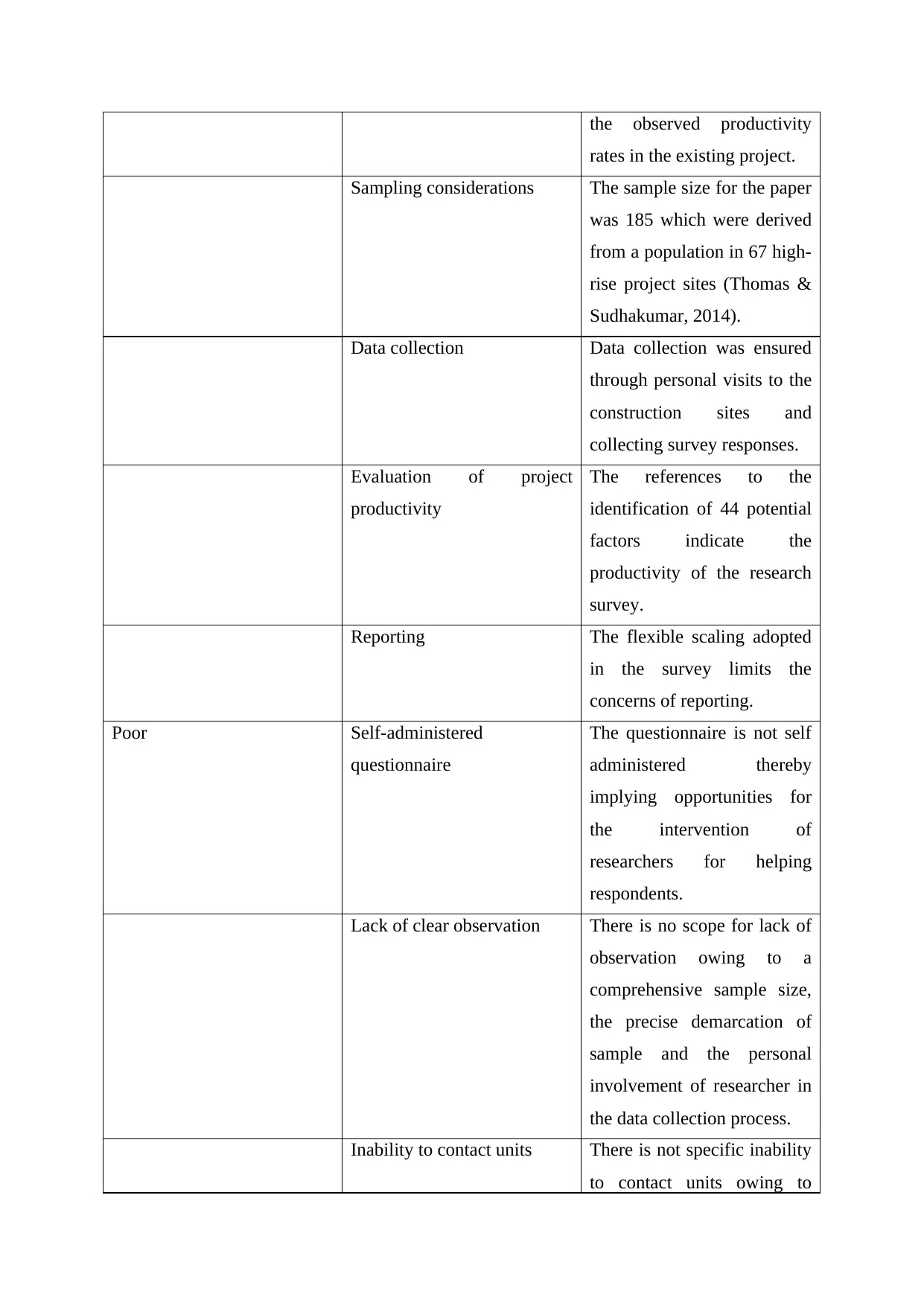
the observed productivity
rates in the existing project.
Sampling considerations The sample size for the paper
was 185 which were derived
from a population in 67 high-
rise project sites (Thomas &
Sudhakumar, 2014).
Data collection Data collection was ensured
through personal visits to the
construction sites and
collecting survey responses.
Evaluation of project
productivity
The references to the
identification of 44 potential
factors indicate the
productivity of the research
survey.
Reporting The flexible scaling adopted
in the survey limits the
concerns of reporting.
Poor Self-administered
questionnaire
The questionnaire is not self
administered thereby
implying opportunities for
the intervention of
researchers for helping
respondents.
Lack of clear observation There is no scope for lack of
observation owing to a
comprehensive sample size,
the precise demarcation of
sample and the personal
involvement of researcher in
the data collection process.
Inability to contact units There is not specific inability
to contact units owing to
rates in the existing project.
Sampling considerations The sample size for the paper
was 185 which were derived
from a population in 67 high-
rise project sites (Thomas &
Sudhakumar, 2014).
Data collection Data collection was ensured
through personal visits to the
construction sites and
collecting survey responses.
Evaluation of project
productivity
The references to the
identification of 44 potential
factors indicate the
productivity of the research
survey.
Reporting The flexible scaling adopted
in the survey limits the
concerns of reporting.
Poor Self-administered
questionnaire
The questionnaire is not self
administered thereby
implying opportunities for
the intervention of
researchers for helping
respondents.
Lack of clear observation There is no scope for lack of
observation owing to a
comprehensive sample size,
the precise demarcation of
sample and the personal
involvement of researcher in
the data collection process.
Inability to contact units There is not specific inability
to contact units owing to
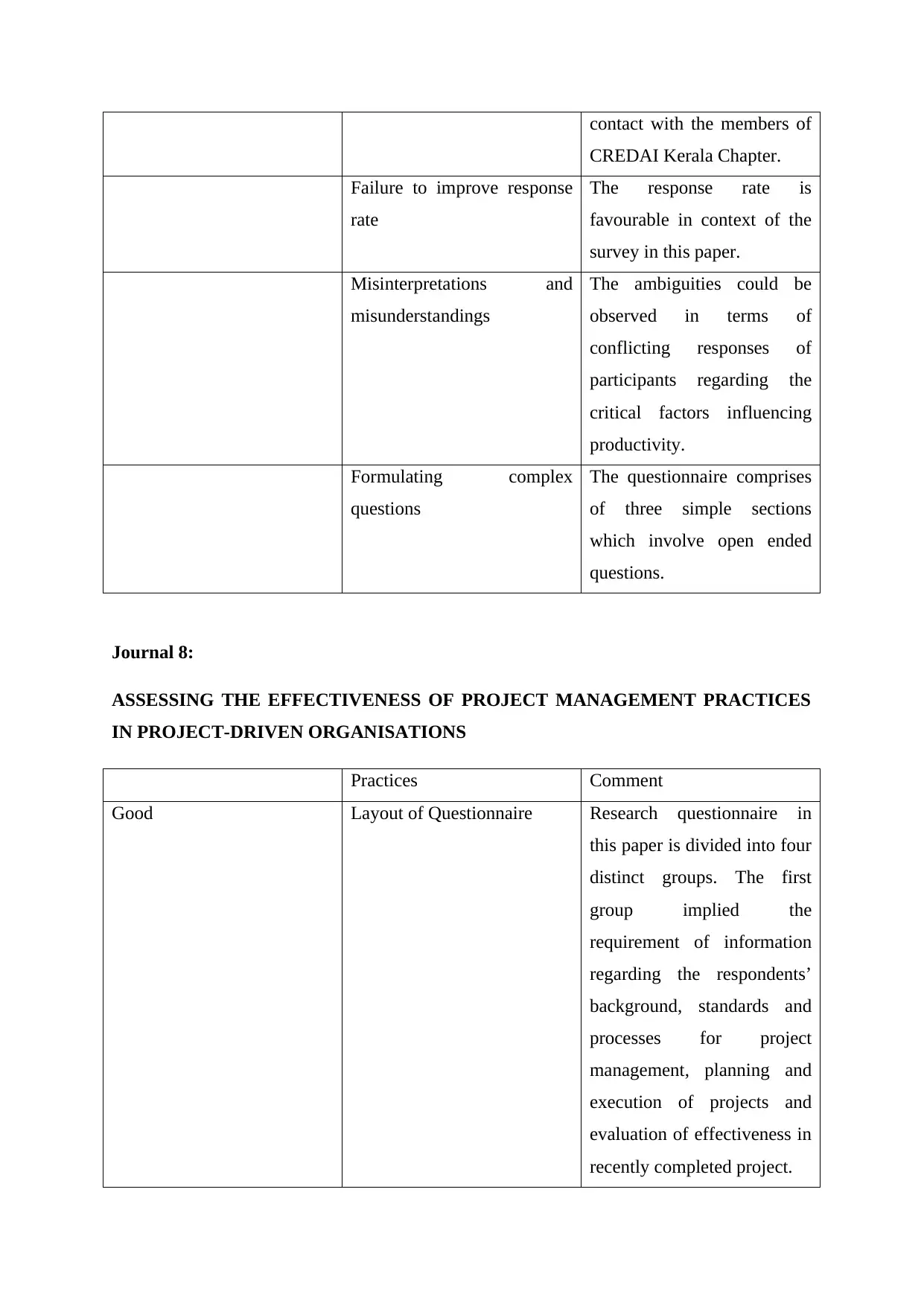
contact with the members of
CREDAI Kerala Chapter.
Failure to improve response
rate
The response rate is
favourable in context of the
survey in this paper.
Misinterpretations and
misunderstandings
The ambiguities could be
observed in terms of
conflicting responses of
participants regarding the
critical factors influencing
productivity.
Formulating complex
questions
The questionnaire comprises
of three simple sections
which involve open ended
questions.
Journal 8:
ASSESSING THE EFFECTIVENESS OF PROJECT MANAGEMENT PRACTICES
IN PROJECT-DRIVEN ORGANISATIONS
Practices Comment
Good Layout of Questionnaire Research questionnaire in
this paper is divided into four
distinct groups. The first
group implied the
requirement of information
regarding the respondents’
background, standards and
processes for project
management, planning and
execution of projects and
evaluation of effectiveness in
recently completed project.
CREDAI Kerala Chapter.
Failure to improve response
rate
The response rate is
favourable in context of the
survey in this paper.
Misinterpretations and
misunderstandings
The ambiguities could be
observed in terms of
conflicting responses of
participants regarding the
critical factors influencing
productivity.
Formulating complex
questions
The questionnaire comprises
of three simple sections
which involve open ended
questions.
Journal 8:
ASSESSING THE EFFECTIVENESS OF PROJECT MANAGEMENT PRACTICES
IN PROJECT-DRIVEN ORGANISATIONS
Practices Comment
Good Layout of Questionnaire Research questionnaire in
this paper is divided into four
distinct groups. The first
group implied the
requirement of information
regarding the respondents’
background, standards and
processes for project
management, planning and
execution of projects and
evaluation of effectiveness in
recently completed project.
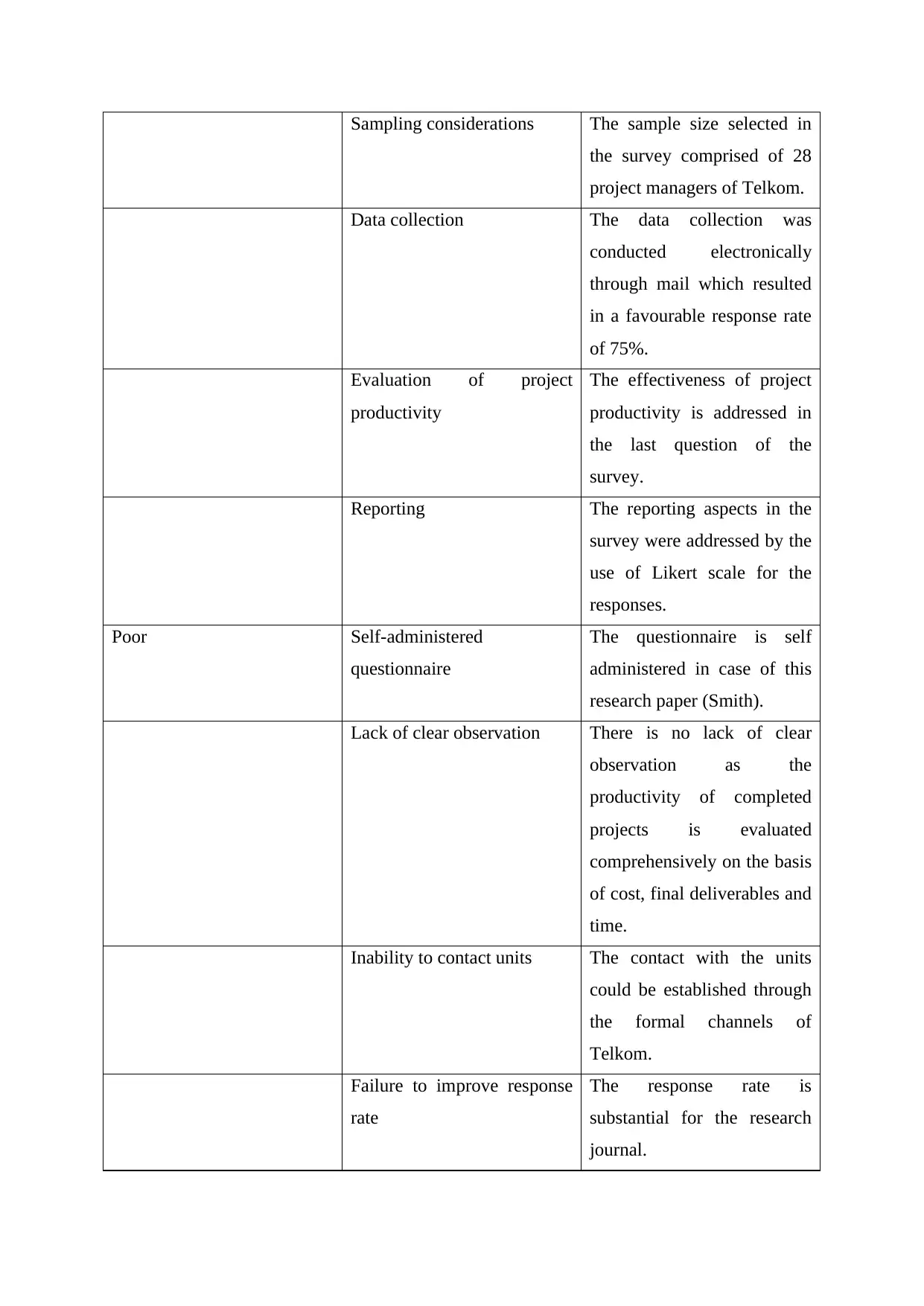
Sampling considerations The sample size selected in
the survey comprised of 28
project managers of Telkom.
Data collection The data collection was
conducted electronically
through mail which resulted
in a favourable response rate
of 75%.
Evaluation of project
productivity
The effectiveness of project
productivity is addressed in
the last question of the
survey.
Reporting The reporting aspects in the
survey were addressed by the
use of Likert scale for the
responses.
Poor Self-administered
questionnaire
The questionnaire is self
administered in case of this
research paper (Smith).
Lack of clear observation There is no lack of clear
observation as the
productivity of completed
projects is evaluated
comprehensively on the basis
of cost, final deliverables and
time.
Inability to contact units The contact with the units
could be established through
the formal channels of
Telkom.
Failure to improve response
rate
The response rate is
substantial for the research
journal.
the survey comprised of 28
project managers of Telkom.
Data collection The data collection was
conducted electronically
through mail which resulted
in a favourable response rate
of 75%.
Evaluation of project
productivity
The effectiveness of project
productivity is addressed in
the last question of the
survey.
Reporting The reporting aspects in the
survey were addressed by the
use of Likert scale for the
responses.
Poor Self-administered
questionnaire
The questionnaire is self
administered in case of this
research paper (Smith).
Lack of clear observation There is no lack of clear
observation as the
productivity of completed
projects is evaluated
comprehensively on the basis
of cost, final deliverables and
time.
Inability to contact units The contact with the units
could be established through
the formal channels of
Telkom.
Failure to improve response
rate
The response rate is
substantial for the research
journal.
Paraphrase This Document
Need a fresh take? Get an instant paraphrase of this document with our AI Paraphraser
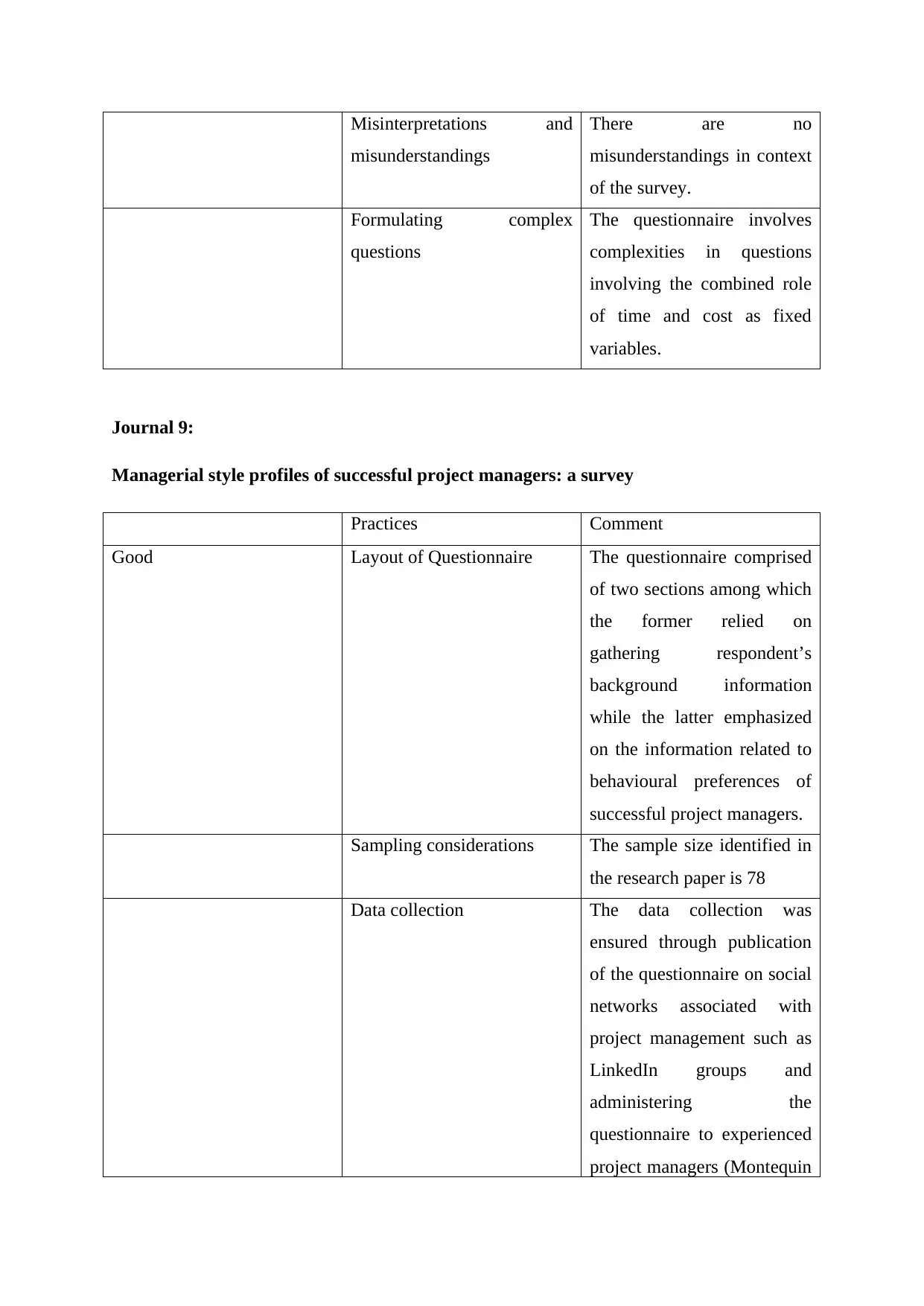
Misinterpretations and
misunderstandings
There are no
misunderstandings in context
of the survey.
Formulating complex
questions
The questionnaire involves
complexities in questions
involving the combined role
of time and cost as fixed
variables.
Journal 9:
Managerial style profiles of successful project managers: a survey
Practices Comment
Good Layout of Questionnaire The questionnaire comprised
of two sections among which
the former relied on
gathering respondent’s
background information
while the latter emphasized
on the information related to
behavioural preferences of
successful project managers.
Sampling considerations The sample size identified in
the research paper is 78
Data collection The data collection was
ensured through publication
of the questionnaire on social
networks associated with
project management such as
LinkedIn groups and
administering the
questionnaire to experienced
project managers (Montequin
misunderstandings
There are no
misunderstandings in context
of the survey.
Formulating complex
questions
The questionnaire involves
complexities in questions
involving the combined role
of time and cost as fixed
variables.
Journal 9:
Managerial style profiles of successful project managers: a survey
Practices Comment
Good Layout of Questionnaire The questionnaire comprised
of two sections among which
the former relied on
gathering respondent’s
background information
while the latter emphasized
on the information related to
behavioural preferences of
successful project managers.
Sampling considerations The sample size identified in
the research paper is 78
Data collection The data collection was
ensured through publication
of the questionnaire on social
networks associated with
project management such as
LinkedIn groups and
administering the
questionnaire to experienced
project managers (Montequin
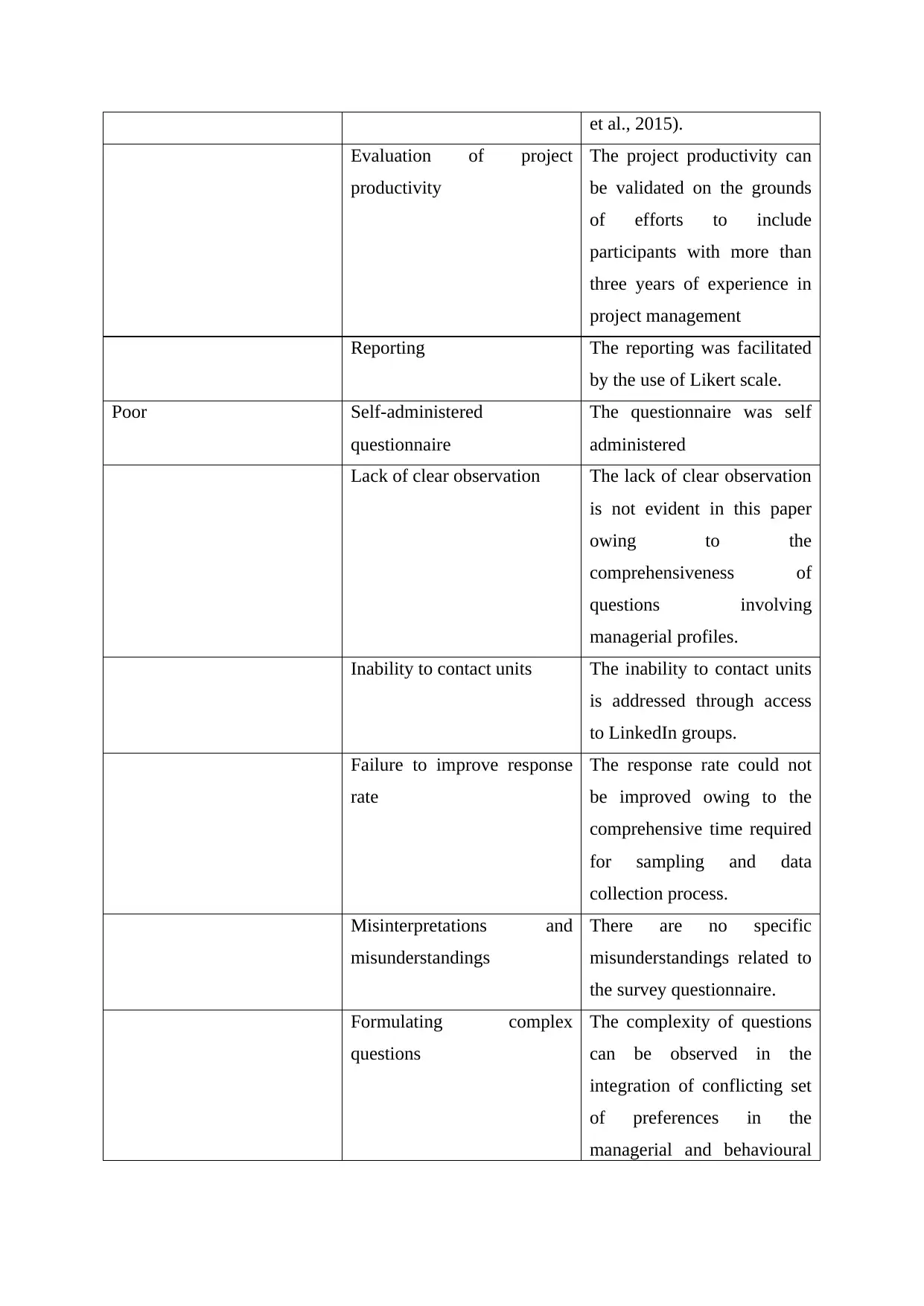
et al., 2015).
Evaluation of project
productivity
The project productivity can
be validated on the grounds
of efforts to include
participants with more than
three years of experience in
project management
Reporting The reporting was facilitated
by the use of Likert scale.
Poor Self-administered
questionnaire
The questionnaire was self
administered
Lack of clear observation The lack of clear observation
is not evident in this paper
owing to the
comprehensiveness of
questions involving
managerial profiles.
Inability to contact units The inability to contact units
is addressed through access
to LinkedIn groups.
Failure to improve response
rate
The response rate could not
be improved owing to the
comprehensive time required
for sampling and data
collection process.
Misinterpretations and
misunderstandings
There are no specific
misunderstandings related to
the survey questionnaire.
Formulating complex
questions
The complexity of questions
can be observed in the
integration of conflicting set
of preferences in the
managerial and behavioural
Evaluation of project
productivity
The project productivity can
be validated on the grounds
of efforts to include
participants with more than
three years of experience in
project management
Reporting The reporting was facilitated
by the use of Likert scale.
Poor Self-administered
questionnaire
The questionnaire was self
administered
Lack of clear observation The lack of clear observation
is not evident in this paper
owing to the
comprehensiveness of
questions involving
managerial profiles.
Inability to contact units The inability to contact units
is addressed through access
to LinkedIn groups.
Failure to improve response
rate
The response rate could not
be improved owing to the
comprehensive time required
for sampling and data
collection process.
Misinterpretations and
misunderstandings
There are no specific
misunderstandings related to
the survey questionnaire.
Formulating complex
questions
The complexity of questions
can be observed in the
integration of conflicting set
of preferences in the
managerial and behavioural
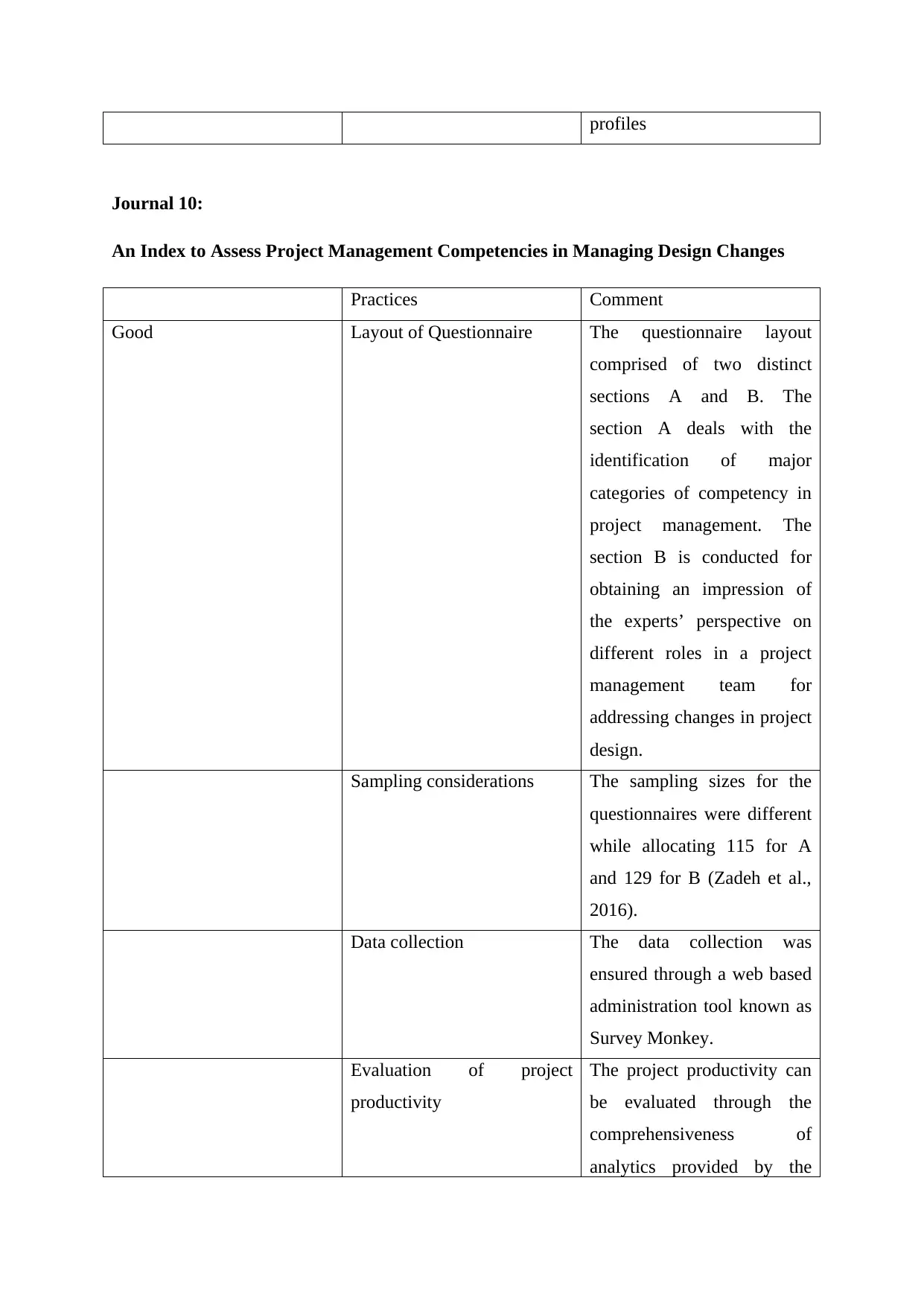
profiles
Journal 10:
An Index to Assess Project Management Competencies in Managing Design Changes
Practices Comment
Good Layout of Questionnaire The questionnaire layout
comprised of two distinct
sections A and B. The
section A deals with the
identification of major
categories of competency in
project management. The
section B is conducted for
obtaining an impression of
the experts’ perspective on
different roles in a project
management team for
addressing changes in project
design.
Sampling considerations The sampling sizes for the
questionnaires were different
while allocating 115 for A
and 129 for B (Zadeh et al.,
2016).
Data collection The data collection was
ensured through a web based
administration tool known as
Survey Monkey.
Evaluation of project
productivity
The project productivity can
be evaluated through the
comprehensiveness of
analytics provided by the
Journal 10:
An Index to Assess Project Management Competencies in Managing Design Changes
Practices Comment
Good Layout of Questionnaire The questionnaire layout
comprised of two distinct
sections A and B. The
section A deals with the
identification of major
categories of competency in
project management. The
section B is conducted for
obtaining an impression of
the experts’ perspective on
different roles in a project
management team for
addressing changes in project
design.
Sampling considerations The sampling sizes for the
questionnaires were different
while allocating 115 for A
and 129 for B (Zadeh et al.,
2016).
Data collection The data collection was
ensured through a web based
administration tool known as
Survey Monkey.
Evaluation of project
productivity
The project productivity can
be evaluated through the
comprehensiveness of
analytics provided by the
Secure Best Marks with AI Grader
Need help grading? Try our AI Grader for instant feedback on your assignments.
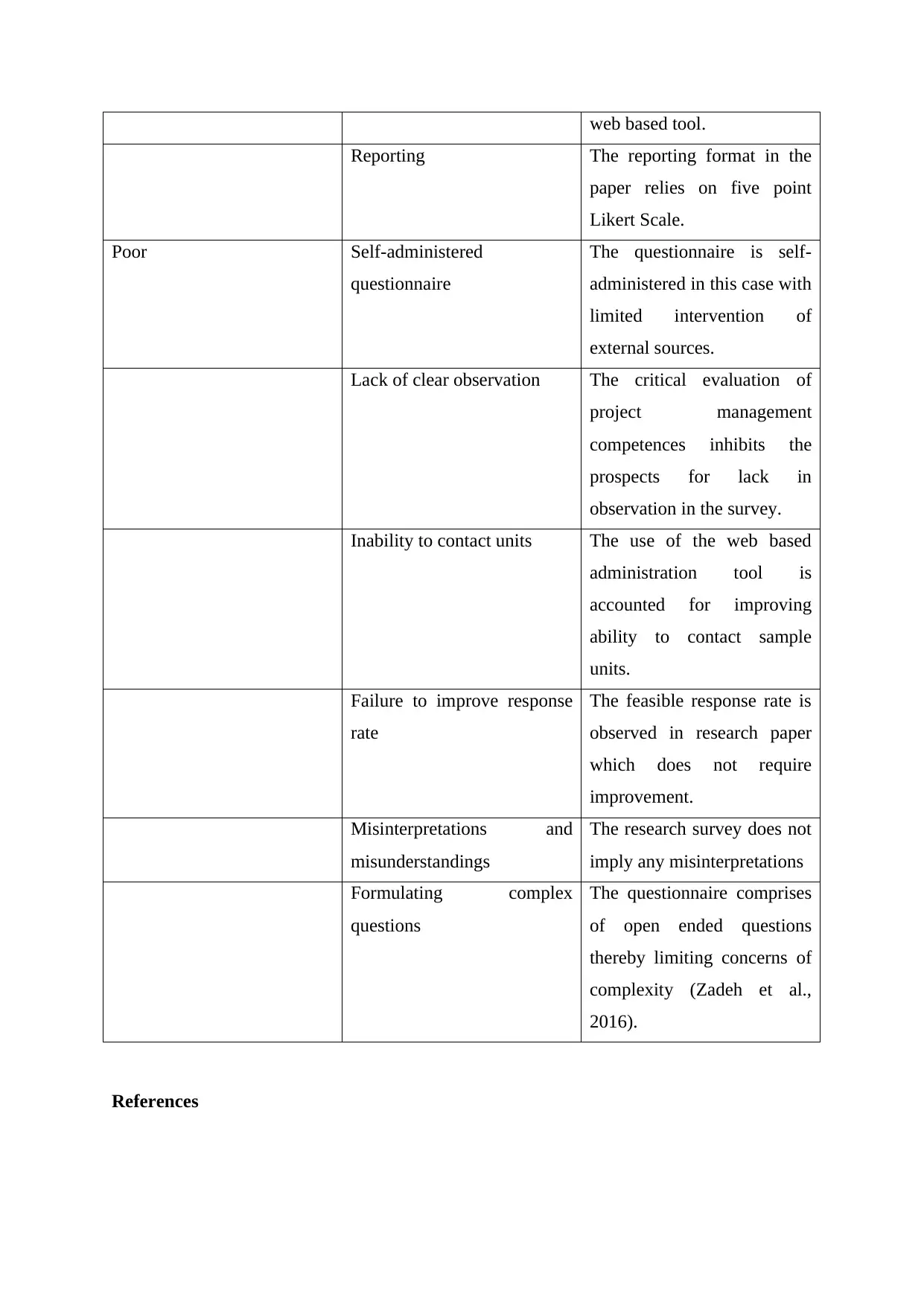
web based tool.
Reporting The reporting format in the
paper relies on five point
Likert Scale.
Poor Self-administered
questionnaire
The questionnaire is self-
administered in this case with
limited intervention of
external sources.
Lack of clear observation The critical evaluation of
project management
competences inhibits the
prospects for lack in
observation in the survey.
Inability to contact units The use of the web based
administration tool is
accounted for improving
ability to contact sample
units.
Failure to improve response
rate
The feasible response rate is
observed in research paper
which does not require
improvement.
Misinterpretations and
misunderstandings
The research survey does not
imply any misinterpretations
Formulating complex
questions
The questionnaire comprises
of open ended questions
thereby limiting concerns of
complexity (Zadeh et al.,
2016).
References
Reporting The reporting format in the
paper relies on five point
Likert Scale.
Poor Self-administered
questionnaire
The questionnaire is self-
administered in this case with
limited intervention of
external sources.
Lack of clear observation The critical evaluation of
project management
competences inhibits the
prospects for lack in
observation in the survey.
Inability to contact units The use of the web based
administration tool is
accounted for improving
ability to contact sample
units.
Failure to improve response
rate
The feasible response rate is
observed in research paper
which does not require
improvement.
Misinterpretations and
misunderstandings
The research survey does not
imply any misinterpretations
Formulating complex
questions
The questionnaire comprises
of open ended questions
thereby limiting concerns of
complexity (Zadeh et al.,
2016).
References
1 out of 23
Related Documents
Your All-in-One AI-Powered Toolkit for Academic Success.
+13062052269
info@desklib.com
Available 24*7 on WhatsApp / Email
![[object Object]](/_next/static/media/star-bottom.7253800d.svg)
Unlock your academic potential
© 2024 | Zucol Services PVT LTD | All rights reserved.





